#Macchu Picchu Bar
Explore tagged Tumblr posts
Text



#Paranoiko Fest#En la casa komas antipatria#Neuronas Muertas#PTK#El terrible y los Cenobitas#Autocrítica OI!#Fujimoris Muertos#Concierto Solidario#Macchu Picchu Bar#Necrocracia#Los Rezios#Autonomia#D.H.K#Materia de Conciencia#Perineo ProD.#SCHMERZ#YAMI SPECHIE#PERLA#ZPECTRUM#Casa Bagre#KluB Vampiro IV.
0 notes
Note
Happy FFWF! Artemis' dream road trip, so to speak? [ellie-e-marcovitz 😊]
Happy FFWF! 🧡 Artemis is one of my more widely travelled OCs. Exploring new places is one of her favourite things to do, and here’s a selection of her top picks…
London - Artemis grew up in London, and it will forever feel like a sort of home to her. She’d recommend Camden, Notting Hill, and Soho.
Prague - I went to Prague earlier this month. Artemis has decided that she would like to live there. What Artemis wants, she invariably gets. She’s a bohemian now.
Istanbul - Artemis’ second placement during her Gringotts training was in Turkey, and she visited Istanbul for one weekend during her time there. She adored the Grand Bazaar. And the Baklava. Yum.
Southern Spain - Artemis would particularly recommend Sevilla for the tapas and flamenco, but she also liked Cadiz, the beaches, and the Alhambra.
Morocco - it’s not hard to get across to Morocco from the south of Spain, as Artemis discovered during her time there. She loved Marrakech and Chefchaouen, but the highlight was getting to ride on a camel, so she would suggest doing that. You can also get more baklava.
Peru - Artemis spent three months here during the summer/autumn of 1992. She loved Macchu Picchu and the rainbow mountain, but more than anything, she loved the alpacas.
Vietnam - her favourite place in South-East Asia. It was here she developed a taste for spicy food, and has since destroyed the tastebuds of almost anyone she has ever cooked for. She found it difficult to choose a favourite place in Asia (beaches and good food are Artemis’ favourite things) but the lantern city of Hoi An tipped the scales in Vietnam’s favour.
Transylvania - Artemis met a vampire here once. Also, after spending a year living in the Carpathian Mountains, she has a soft spot for the Romanian countryside.
Ireland - Artemis went to Dublin when she attended the wedding of Barnaby Lee and her former Quidditch teammate Ellie Hopper in Ireland. Other former teammate Lizzie Jameson happened to be doing the same thing, and she and Artemis had a very fun spontaneous night out, fuelled by Guinness and shots. Artemis has returned to Dublin a few times since, she loves the bustle of the city, its lively bars and good music. @thatravenpuffwitch @lifeofkaze
Norway - Artemis wasn’t in a position to fully enjoy Norway on her first visit in 1997, but has since returned and appreciated it more. She would recommend the island of Svalbard for the Northern lights, the fjords of the countryside, and the Viking town of Skalafell. Just try not to take some of its inhabitants too seriously. @kathrynalicemc
USA - after years of estrangement, Artemis actually visited some of her American relatives in the noughties. She loved California, especially the beaches on the West Coast, the vineyards in the North, and Yosemite National Park. She’d go back there again. Her favourite place in the States was Hawaii, however.
Mexico - again, go for the food. Stay for the festivals - particularly the Day of the Dead and the 5th of May.
The one place Artemis has never been but is desperate to go is Madagascar. She’s seen lemurs at the zoo before, but never in the wild.
17 notes
·
View notes
Text
CUSCO BY DAY AND NIGHT
07.09, Cusco
Zum Frühstück gab's neben einem exotischen Obstsalat erstmal einen Cocatee.
Peru ist mit 45% (Stand 2010) das Land mit dem höchsten Anteil der weltweiten Coca-Ernte. Ob Cocablätter, Cocatee oder Cocabonbons - man kann es in jedem Shop kaufen und ist daher hier wortwörtlich in aller Munde.
Hier ein paar Funfacts:
"Getrocknete Cocablätter enthalten ca. 0,5 bis 2,5 % Alkaloide, Coca-Alkaloide, davon bestehen bis zu drei Viertel aus Kokain.
Außerdem enthalten sie relativ große Mengen an Kohlenhydraten, Calcium sowie Proteinen, Eisen, Vitamin A und Vitamin B2.
Das Kauen von Coca-Blättern ist in den Anden sowie im Tiefland des Gran Chaco seit Jahrhunderten verbreitet. Die Blätter werden als Genussmittel, als Nahrungsergänzungsmittel und für kultische und medizinische Zwecke genutzt. Sie helfen, Hunger, Müdigkeit und Kälte zu verdrängen und sind sehr wirksam gegen die Höhenkrankheit, da sie die Sauerstoffaufnahme verbessern.
Der Tee „Mate de Coca“ ist in Peru und anderen Andenregionen Nationalgetränk. In Peru, Bolivien und im Norden Argentiniens gibt es ihn, fertig in Teebeutel abgepackt, in vielen Supermärkten. Er enthält ca. 1 g getrocknete Cocablätter pro Teebeutel. Seine Wirkung ist mit der von starkem Schwarztee oder Kaffee vergleichbar, außerdem kann er Magenbeschwerden lindern.
Die Verarbeitung der Cocablätter zu Tees wird in Peru sogar über die Nationale Koka-Gesellschaft staatlich gefördert. Da die Teemischung Pflanzenteile der Coca-Pflanze enthält, unterliegt diese dem deutschen Betäubungsmittelgesetz, weshalb allein der Besitz oder die Einfuhr solcher Teebeutel strafbar ist."
Tja, anscheinend leider kein gutes Mitbringsel… schade!
Nachdem Frühstück ging es erstmal zur Freetour. Einfach immer super am Anfang jeder Reise, um mehr über die Geschichte und Kultur des Landes zu erfahren, lokale Tipps und einen groben Überblick über die Stadt zu erhalten.
Hier ein paar Funfacts aus der Tour:
Cusco hat 420.000 Einwohner
Cusco bedeutet " Nabel der Welt" und war einst die Hauptstadt des Inkareiches
Die Markthalle San Pedro wurde von Gustave Eiffel entworfen (ja, genau der, nach dem der Eiffelturm benannt wurde) Sie ist allerdings ziemlich hässlich: Man scherzt, dass Herr Eiffel aufgrund der Höhe seine Inspiration verloren hat ;)
Die Flagge von Cusco ist regenbogenfarben, ist aber keine "gayflag" wie unser Guide klarstellte
Es gibt drei offizielle Landessprachen: Spanisch, Quechua und Aymara
Die "Inkas" waren eigentlich nur die Könige, das Volk waren die Quechua
Peru war 300 Jahre von den Spaniern besetzt - überall, wo vorher Inkatempel standen in der Stadt, stehen jetzt Kirchen (zum Glück haben die Spanier Macchu Picchu nie gefunden, sonst würde da jetzt ne Kirche stehen)
Jetzt sind 70% der Peruaner katholisch
Die Steine in den Mauern der "Inkas" sind so perfekt geschnitten, dass nicht mal ein Blatt Papier dazwischen passt.
Auf die noch erhaltenen Grundmauern der Inka haben die Spanier ihre Häuser im Kolonialstil drauf gebaut
Ayahuasca und der San Pedro Kaktus sind beides Pflanzen mit psychoaktiven Wirkstoffen und werden gerne im Schamanismus für rituelle Zwecke verwendet. Unser Guide meinte: "Die Schamanen nennen es Medizin, ich nenne es eine Droge."
Abends wollten wir nochmal das Nachtleben in Peru erkunden, weil man das erstens in Cusco, der Partystadt, angeblich gut kann, und zweitens weil wir wussten, dass wir in den nächsten zwei Wochen keine Gelegenheit mehr dazu haben würden.
In der ersten Bar kam nach einer Weile ein Peruaner zu uns und fragte, ob wir Deutsche seien. Wir bejahten und er freute sich, denn er hatte offenbar eine Wette gewonnen;) Danach kam sein Kumpel zu uns und redete in ziemlich perfekten Deutsch mit uns. Er kam aus Kolumbien und ist dort auf eine deutsche Schule gegangen, angeblich eine der besten in ganz Kolumbien. Zu ihnen gehörte noch ein Mädel aus Serbien.
Wir gingen dann gemeinsam in den Chango Club. Mitten in der Woche war der Club rappelvoll! Es wurde eine grandiose Nacht (mit einigen Pisco Sour und bester Tanzmusik), die ungeplanter Weise erst um 6 Uhr morgens endete.
Der Weg vom Club zum Hostel war nicht weit, wurden aber netter- und glücklicherweise begleitet. Denn wie wir nach ein paar Minuten bemerkten, wurden wir von einem ziemlich betrunkenen Creep verfolgt. Wir fanden die Situation witzig, da der Typ so betrunken war, dass er dachte, er könne sich unauffällig hinter einem Laternenpfahl verstecken.😂🙈
Als wir dann durch unsere Hosteltür verschwanden, mussten wir jedoch schnell die Tür schließen, denn er wollte offensichtlich mit rein. Er stand dann 10 Minuten vor der Tür und hat betrunken vor sich her geredet, er sei von der Polizei usw. Der Typ von der Rezeption hat dann die richtige Polizei gerufen, aber glücklicherweise ist der Creep nach 10 Minuten von alleine abgezuckelt…
What a day and night!








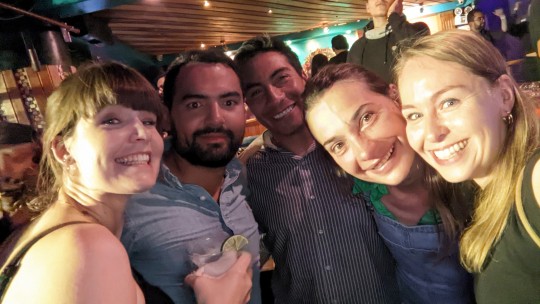

0 notes
Text
I saw her at Neruda’s house,
carved a century ago
to keep vigil over the waves
from the prow of a ship,
with great brown eyes
and hair in a whirl,
now hovering silently
above the poet’s table.
That night in the bar
she appeared at my elbow,
the same eyes, the same hair,
not paint and wood but flesh.
He likes for me to be still,
she grinned. I don’t like to be still.
I want to climb the steps
at Macchu Picchu.
I want to talk about poetry all night.
I want more wine.
-Martín Espada, from The Republic of Poetry
0 notes
Text
We wandered along the edge of the deepening canyon. With every step, the stream’s chill, clear waters cut ever more deeply into the volcanic basalt that formed the ground beneath our feet. Gusts of wind pulled on the storm-twisted shrubs and tawny shocks of long grasses, pausing to tug at our jackets before rushing down to join the water cascading steadily into a valley hazey with distance. We stopped and squinted again at the black and white map we’d printed off at a cafe and compared it with a picture we’d taken of a map on a sign the day before. Somewhere in Colombia’s Los Nevados National Park, we guessed we were in the Valle de los Perdidos. What we didn’t have to guess was that we were lost.
As a side note: thank you, America, for having drinking fountains. On another note: thank you, Colombia, for having syrup chicken.
Some days prior we’d arrived in Bogotá on a Sunday, and on a holiday, Dia de la Virgen. Consequently, the city of eight million souls had felt almost deserted. We’d known immediately what we wanted to do in Colombia: we sought the páramo, the high-altitude tropical grasslands so characteristic of the Andes. We managed to find the National Parks office downtown and discovered when they opened (a day later) and when we returned that their own maps and information on their parks, well, sucked. National parks in America arebasically chock-full of maps, info and trail routes you can grab from a visitors’ center with as easily as you’d find a drinking fountain. As a side note: thank you, America, for having drinking fountains.On another note: thank you, Colombia, for having syrup chicken.
DCIM101GOPROGOPR5318.
There was enough information to figure out which parks were closest to us and Bogotá, and with the help of some outdated guidebooks we’d sniffed out in a secondhand bookshop we’d ultimately selected the promising slopes of Los Nevados National Park. The bus ride to the town nearest its base was a thrilling introduction to one of South America’s most beautiful and often shunned countries possessed of all the amenities a world traveler could ever desire. “Hey, Shawn, look, they have food here! There’s bananas! Also, rice!”

They even have those beefed-up weasel things!
Indeed, the casual charm of nearby Ecuador and the ever-Instagrammable llamas of Macchu Picchu—paired with Colombia’s decades of rebel insurgencies and drug wars— seems to have dissuaded many travelers from visiting Colombia. Things have been on a slow chill-out since 2012, though, and a final peace accord was ratified on November 29, 2016, like, at least a week and a half before we bothered to show up. Correspondingly tourists are a flockin’. Flockin’ tourists. All up in Colombia’s bizness.
Passing through the larger city of Ibague, we finished our bus ride in Armenia. Armenia, Colombia, is incredibly like Cotopaxi, Colorado and Cuba, New Mexico (both of which I’d seen in the weeks prior) in that it scarcely resembles its foreign namesake. Fascinating, I know. Somewhat more interestingly, According to a Wikipedia article without any sourcing, “it is believed that the name [of the city] was changed to Armenia after the country of the same name, in memory of the Armenian people murdered by the Turkish Ottomans in the Hamidian Massacres of 1894–97 and later the Armenian Genocide of 1915–23.”
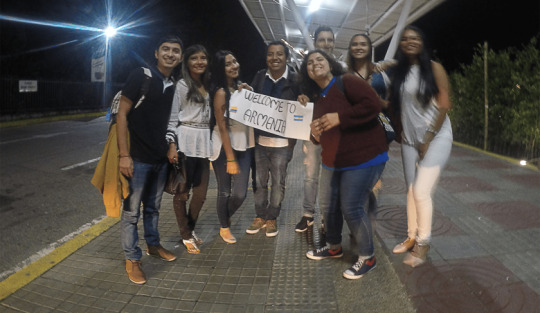
The tourist office informed us hikes into the páramo could only be done with a local guide, and so they’d gotten rid of all local maps that showed us the way to go.
We stopped at an hospedaje in Armenia and ferreted out some basic topographic maps of the national park with Google-fu. The next morning, we took a minivan uphill to the small town of Salento, which we walked around in search of additional information. The tourist office—according to old blogs, a good source of mountain intel—now informed us hikes into the páramo could only be done with a local guide, and so they’d gotten rid of all local maps that showed us the way to go. But if we wanted, they explained, they knew a guide who could take us where we wanted to go, for a reasonable price. We said thanks, said we’d keep them in mind, and marched off to the mercado, where we bought some bread and apples. Back in the main square of Salento we hopped aboard one of the many tourist jeeps that regularly ferried tourists uphill towards the famed Cocora Valley, an Instagram-famous land replete with wax palm trees whose lofty fronds once soared above the rainforest canopy and now stood vigil picturesquely above grassy, denuded slopes of grazing cattle.

We decided the Cocora Valley would best be enjoyed as the downhill section of a loop, and so we instead set off towards up the first bit of the loop, a side canyon leading to a placed boasting to be the Casa de los Colibris—the Hummingbird House.

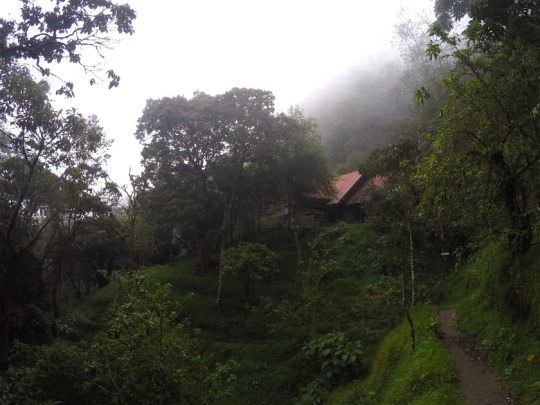
As we advanced beneath lumbering packs, we attempted to avoid stepping in water and mud, which Shawn was able to do for a grand total of three seconds when a stream-embedded log capsized underfoot. We eventually made it to a hummingbird sanctuary which was full of, like, day-tripping Europeans drinking tea and stuff. As we sipped the warm, sweet cinnamon tea we’d purchased we happily discovered an old topographic map affixed to the wall. The caretakers told us the páramo was still several hours uphill. Unfamiliar with the path and just a couple hours from dusk, we decided to stay the night and resume our trek early in the morning. We paid them a couple of dollars and slept on the floor of a wooden building still under construction, doors left open to the mist that crept in as the sun set.
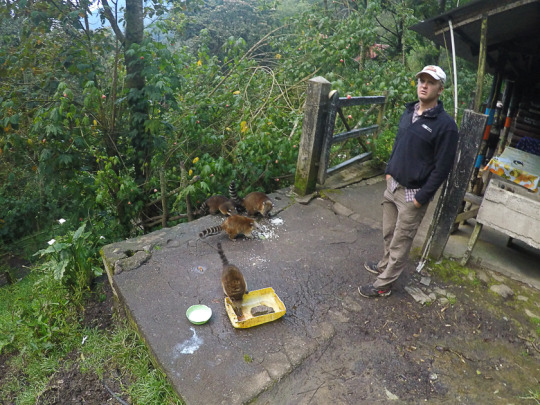
COATI TIME!!
Out on the trail the next morning, we passed two men folding a tarp in a trailside clearing in the early light. Dressed in knee-high rubber boots, shorts and t-shirts, one wore a white beanie, the other donned a bowler hat and carried juggling pins. Just then, a group of European trekkers descended in boots slathered with mud. Their Colombian guide seemed upset when he learned we were on our own. “You need a guide,” he said sternly, “the National Park guard at the park border won’t let you pass on your own. Also, not only could you get lost in the fog, you could die.” We shrugged at his empty warning—we’d died inside long ago. The group then continued onward, the guide apparently forgetting to ask our Colombian companions where their guide was.


Alone again with our new Colombian friends, we learned their names and talked a little bit more. Somewhat dismissively, I decided they seemed friendly, buena onda chaps but people I’d likely never see again, being the expert hiker and Fast-Walker-Up-Things I so obviously was. We bid them good-luck and good-bye, and good-walked all up the trail at a good pace.

Before long, we came across the National Park office, inhabited by a kind human being and a raucous, tethered dog. We didn’t ask this kind sir if two Americans needed a guide, and neither did he. Instead, he gestured for us to sign our names on the trail register and he told us about a time when he’d spied the elusive Andean sun bear, a shy species that eats a nutritious variety of bromeliads, grubs, and Michael Bolton fans. He told us one of the greatest difficulties in managing the park was the presence of families who had been settled on the high plain a generation or two ago, and now they had always lived there, darnit, depending on cattle to eke out an existence. The cows pooped everywhere, he complained, and their manure tainted many of the streams and rivers the cities below depended on for water, including the brook that ran nearby. Cows, I concluded, are terrible people.
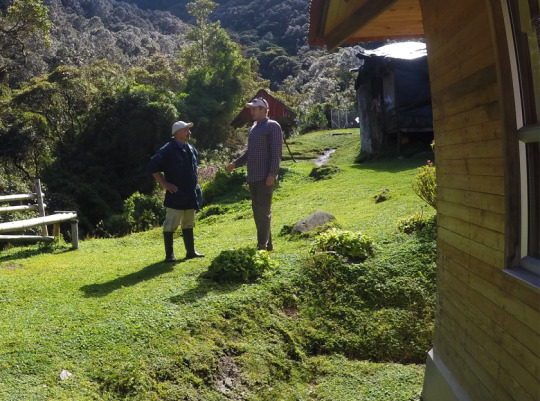
We’d packed some snazzy Gatorade-brand protein bars, a strange colloid of high-tech Rice Krispies and caramel whey stuff generously lacquered in chocolate-flavored palm oil coating.
Wheezing, hungry and sun bear sighting-less, we busted out our grub for lunch, consisting of the last of our bread and apples from the Salento mercado and some snazzy Gatorade-brand protein bars, a strange colloid of high-tech Rice Krispies and caramel stuff generously lacquered in chocolate-flavored palm oil coating. “This is delicious,” remarked Shawn, and I agreed. We’d packed enough for the duration of our journey in the páramo, some three dozen 250-calorie packages of coagulated-whey America.

Whilst we feasted upon this chocolaty bounty, we were joined by Camilo and Andres, who apparently hadn’t been trailing too far behind us. After chatting for a bit. we started up the hill again, this time together. The trail was a downright slog, ofttimes covered wholesale by deep patches long blob areas of mud. Resistance was futile, and before long our shoes and legs had been assimilated by the mountain.
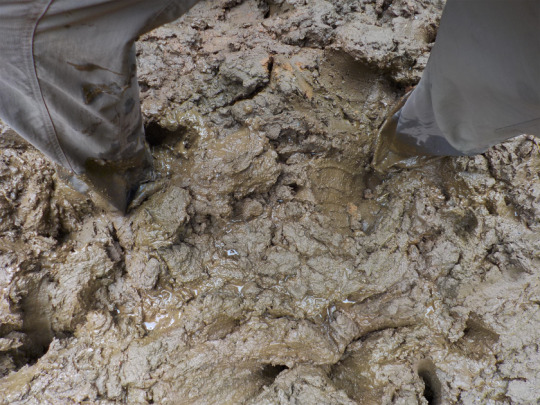
Weary hours passed as we made our way beneath the drab green cloud forest canopy, each tree trunk and branch covered in a profusion of feathered, silvery lichens, ruddy mosses, and bright fungi.


The 50% Great Worm
Abruptly, the thick forest gave way to amber sedges and tufted grass. Interspersed among the lower vegetation were curious plants, solitary stalks the width of a child’s wrist growing anywhere from several inches to several times the height of a deer in platform shoes. Topping these stalks were leaves covered in fuzz, a soft, green flannel. These curious plants, these frailejónes, indicated we had reached the páramo.

Camilo, Andres, Shawn and I rejoiced as we followed the trail up tawny ridges, marveling at the views and shivering as the alpine winds–no longer slowed by trees–tore at us and our belongings.
DCIM102GOPROGOPR5601.
DCIM102GOPROGOPR5608.
DCIM102GOPROGOPR5598.
DCIM102GOPROGOPR5612.
DCIM102GOPROGOPR5615.


At length, the trail led us to a farmhouse and hospedaje, the first of two in the area. But we had a tent we’d lugged up the mountain, darnit, so we advanced on to the second hospedaje, leaving Camilo and Andres behind.



begone, peasant…
A European sort excoriated us when we told him we’d flown to Colombia and would be flying out. We took no offense, knowing without having to ask he’d walked slowly across the entire Atlantic seafloor from Western Europe to arrive.
The hospedaje was a bit further than it’d been made out to be. Even if we’d wanted, they didn’t have any available rooms with beds—a European tour group presently infested these—but they did have a toilet, and this sneaky fancy-person house feature nabbed us right in the comfort organ, pzang! For a couple dollars we set up our tent in a room consisting of a concrete floor walled off from the wind. Our shoes were a mess from the day’s mud slog, so after a scrub in a tiny rivulet we hung them by their shoelaces on the eaves of the house, where they dripped and swung in the stiff nighttime wind. We talked a bit with the other guests; one guy who told us the national park was under threat of huge mining developments and another sort who excoriated us when we told him we’d flown to Colombia and would be flying out. We took no offense, knowing without having to ask he’d walked slowly across the entire Atlantic seafloor from Western Europe to arrive.

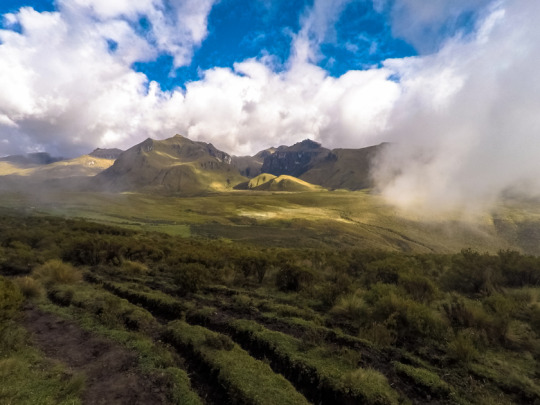
View from the hospedaje, and a distant valley to be explored some other day
We woke up before dawn and set out for some hot springs a number of miles away. The hike was visually nice and not too chilly. As we walked, we breakfasted on a protein bar each. We’d now eaten them for three straight meals, and they didn’t seem to be as good as we first remembered them.
DCIM102GOPROGOPR5664.
DCIM102GOPROGOPR5670.
DCIM102GOPROGOPR5693.
DCIM102GOPROGOPR5685.
DCIM102GOPROGOPR5693.
DCIM102GOPROGOPR5703.
DCIM102GOPROGOPR5670.
DCIM102GOPROGOPR5685.
We dropped in elevation from our spot the night before, passing through frailejónes and emerging onto a flat, grassy plain. Uphill to our right, a 20 m waterfall slipped over orange-ish rocks, indicating geothermal activity. Ahead of us, the trail seemed to go through the center of the wide plain and through a herd of cows.
DCIM102GOPROGOPR5715.
DCIM102GOPROGOPR5717.
DCIM102GOPROGOPR5719.
DCIM102GOPROGOPR5719.
DCIM102GOPROGOPR5715.
DCIM102GOPROGOPR5717.
We walked for a while, the trail petering out. We continued gamely, figuring it would re-appear as is often the case with less-used trails. It didn’t, but we headed anyways in the general direction we thought we were supposed to be following and walked along an chill river which deepened into a gully, then a gulch, then grew into a canyon. We kept the canyon to our left side, still keeping a lookout for the trail. Ahead, the canyon could be seen descending far, far, below. It didn’t look impassable, but it also seemed… wrong.

The canyon begins to deepen
It was almost as if OKAY LOOK WE GOT LOST AND I THINK THIS HAS BEEN ESTABLISHED I HAVE RUN OUT OF FANCY FEAST DESCRIPTION POINTS FOR THIS OTTER MEMORY AND IF I KNEW HOW WE HAD GOTTEN LOST WE WOULDN’T HAVE DONE SO so anyways we finally halted when a steep ravine cut across our path from the right, and consulted what little information we had. A future version of ourselves would have a GPS-enabled smartphone with offline locating-powers to divine our location, but present-us had a small paper map, some grainy pictures and a desire to not lose any more of our hard-gained elevation. Maybe… eating would help us think. “Hey, do you want a protein bar?” I asked my brother, waggling one temptingly in front of his face. “Ugh,” he said in revilement, and rose to leave instead. “You might be lost,” he continued, “but I was just a little disoriented. The trail is up that way.” He pointed up the ravine towards Tolima above. “Good thing it’s not foggy.”

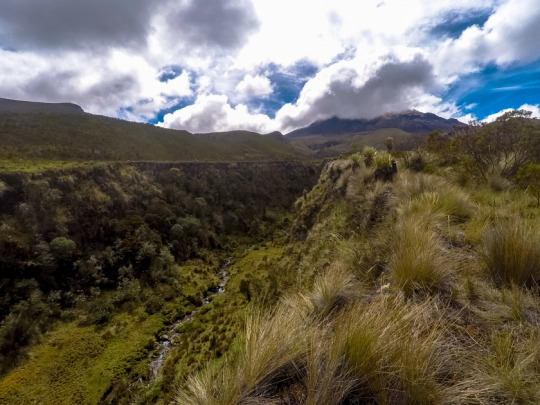
We climbed for a while, seeing nothing besides sweet fuzz-plants and weird moss.

Then, movement, up ahead. Two figures picked their way into the ravine—one with a beanie, the other with a bowler hat and juggling pins: Camilo and Andres.

Enthused but tired, we slithered up to meet them with the sudden enthusiasm of weasels that have just encountered a roadkilled ‘possum—astounded, thrilled.
Enthused but tired, we slithered up to meet them with the sudden enthusiasm of weasels that have just encountered a roadkilled ‘possum—astounded, thrilled. They seemed pleased, but not surprised to see us. They’d also lost the path for a bit, but had stayed closer to the mountain above and hadn’t gotten lost. As we chatted, I noticed what appeared to be a twisted piece of aluminum, two feet long, torn jaggedly at the edges and bearing many small rivets. Curious.
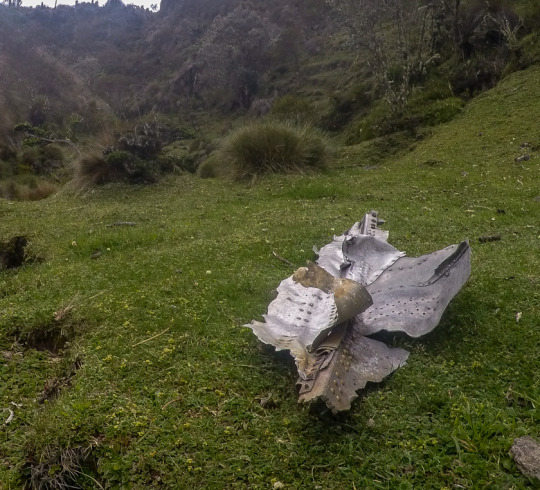
We left the ravine together, Shawn and I trudging from exhaustion. The trail would rise and fall several times and traverse some marshy, sulfurous areas before finally cresting a ridge somewhere around 13,500) feet elevation.
DCIM102GOPROGOPR5775.
DCIM102GOPROGOPR5772.
DCIM102GOPROGOPR5781.
DCIM102GOPROGOPR5777.
DCIM102GOPROGOPR5783.
We dropped and walked around a bend and beheld a green carpet of verdant grass far below us. A handful of small corrugated-roof buildings clustered alongside two small pools which steamed visibly. We had arrived at the hot springs. (12,795 ft elevation)
We sat in the warm waters of the pool and soaked as the the sun set. We’d hiked up the hill above the settlement fifty feet at a time before we’d collapse to the grass, breathing ragged with exhaustion. “Why… why are we so tired?” Shawn muttered querulously, “The elevation… maybe?” We were somewhere around 13,000 feet, so this was certainly part of it, but it didn’t seem complete. I was doing better, overall, and this gave me an idea. “Shawn, how many of those bars did you eat?” “Bars?” “The protein bars.” “Oh. Gross. Um, one in the morning, one later… two?” ‘You’ve eaten 500 calories today. I’ve eaten 750. We should be eating maybe… 3,000 calories each up here. That’s why we can hardly move.” Indeed, though our bodies desperately needed food, our minds had concluded nauseously we they wanted nothing to do with our Gatorade-endorsed mainstay. Unfortunately, it was also all we had left. We weren’t in danger of running out, but actually stomaching the things was becoming most unpleasant.

View above the hot springs, our green tent can be seen below. Note where grazing takes place.
The view from the top of the ridge had been tremendous, but the simmering waters of the springs were better. It was easy to forget we had been too weak to reach the very top of the hill, and more relaxing to consider the mysterious pictographs we’d seen on the rocks partway up the slope. The caretaker didn’t know how old they were, but by their faded condition it seemed people had been visiting this area for a very long time. What kind of world had it been, then? Did people live up here? How far had the cloud forests extended below? Had there been pizza? What about syrup chicken?
DCIM102GOPROGOPR5796.
DCIM102GOPROGOPR5793.
DCIM102GOPROGOPR5801.
DCIM102GOPROGOPR5808.
DCIM102GOPROGOPR5871.
DCIM102GOPROGOPR5864.
DCIM102GOPROGOPR5813.
DCIM102GOPROGOPR5802.
The springs themselves had certainly been changed. The water was piped from slightly above the settlement to a series of two pools. The first was a sitting-depth pool the size of a large hot tub and very warm indeed, the water exited this pool and dropped about ten feet until it reached a larger, more tepid pool below, probably 20 feet/6 m across. The water here ranged from 3-6 ft deep, the floor a slick bedrock in places. The edges of the pool were made of long bands of riveted aluminum. Investigating further, we noted these same pieces of metal could be found supporting various parts of the spring pool complex and its surroundings, including the walkway between the pool and the mud-daubed structure above it. Two shedlike areas were full of scrap metal, all made of the same riveted aluminum.
They were pieces of a wrecked airplane.
They were pieces of a wrecked airplane.

As I’ve written this overly long, boring account I’ve wondered about the identity of this plane. When did it crash? Who did it carry? Where were they headed? I tried to suss out its identity online, and followed many wrong leads before learning there had been many, many crashes in Colombia. Eventually, I found a site that explained there were had been 55 crashes in Colombia from 2000-2015, and 414 total crashes since 1920. This site helpfully mapped out the more recent crashes, and of these just one was anywhere near the hot springs, near La Venecia on the map below.
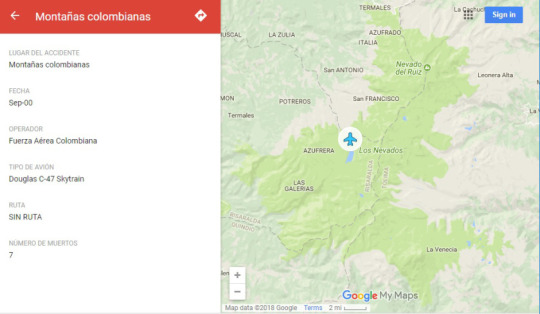
The site of the crash is less than a day’s walk from the springs.
This particular plane crash was flight FAC-1659, a Vietnam-survivor Douglas C-47 Skytrain apparently used in anti-rebel fighting.
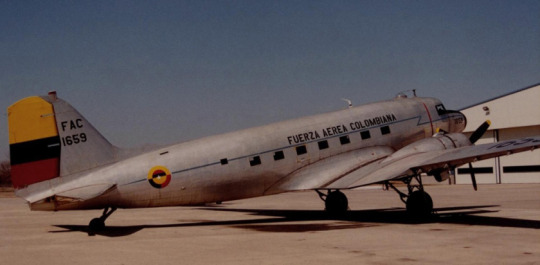
Military plane—->leisure pool?
Further e-search into its demise begins to reveal conflicting information—supposedly crashed on an 11,200 ft tall mountain called Cerro Montezuma: actually a mostly-flat area 4,400 f/1350 m in elevation, but actually it crashed on its return to the airbase, and actually it crashed in either the Serrania de la Tatama or the Nevado del Tolima mountain areas, which are in completely opposite directions a hundred miles apart. Was this our mystery plane, carefully packed mile by mile in manageable pieces by horseback to the springs, or was it the remnants of some other hapless flying machine?
I have no idea. When I would try to find the caretaker the next morning to ask him where he’d come across the metal, I’d learn he’d gone into the hills.
We spent the evening hanging out with Camilo and Andres and discussed plans for the morning. “You guys staying tomorrow?” I asked. “Well,” Camilo said, “We thought there’d be more people here. We thought maybe we’d do a little juggling for the crowd to offset the cost of coming here. But it’s just us. And we still have to earn enough for our bus fare back home somewhere.” Indeed, it was just the four of us, besides the quiet, but enigmatic caretaker, who had told us at times there were dozens of people camping at the springs. “We’re just going to go back the way we came,” said Andres, “make it home by the evening. What about you?” “Our flight leaves in two days, so we’re taking off tomorrow as well.”
We spent the rest of the evening companionably. I choked down a Gatorade bar. Shawn demurred. “Maybe tomorrow,” he said.

The next morning dawned cold, clear and beautiful, with few clouds, illuminating a mountainside frailejónes in rosy morning light. I returned to the tent to find Shawn awake, but reluctant to leave his sleeping bag cocoon. “Is my swimsuit out there?” he asked. “Here,” I said, and handed him frozen swim trunks. Shawn glared at the fabric Frisbee and considered for a moment. Looking outside and seeing the coast was clear, he ran across frosted grass a short distance to the pool and jumped in, swimsuit in hand. “Thawed at last,” he said as he pulled it on.
DCIM102GOPROGOPR5860.
DCIM102GOPROGOPR5873.
After the tent had dried in the sun, we reluctantly left the spring behind for the last time. As we packed up our stuff, we came across our protein bars. They weren’t bad, per se, they just needed to be eaten in reasonable quantities. I had an idea. “Hey, guys, would you guys be interested in trading for any protein bars?” “Sure,” Camilo and Andres responded. They didn’t really need the food, but now they were headed back down to the city they had more than they wanted. Trying a bar might be alright, though. I returned with four of our eight remaining bars, trying to be generous. After a minute they emerged from their tent with a massive bag of roasted, shelled peanuts, a couple pounds, maybe, and handed them over with a smile. This bag of legume loot even had candied toffee peanuts mixed in. It was a treasure, a thing most crunchy and sweet. We’d just traded for peanuts, and it was glorious.
We’d just traded for peanuts, and it was glorious.
******
After we’d said our goodbyes to our friends—for real, this time—we’d taken off to the south, leaving the high mountain plains behind and entering the cloud forest. Energized and enthused by our peanut bounty, we walked for hours.
DCIM102GOPROGOPR5886.
DCIM102GOPROGOPR5879.
DCIM102GOPROGOPR5904.
DCIM102GOPROGOPR5896.
We reached the small town of El Salto (elevation 3376 m/11076 ft), and waited by what seemed to be some kind of hospedaje. After an hour or so, a lady returned and informed us the beds were $3 dollars each, or we both could stay in another room sans beds for $2.
DCIM102GOPROGOPR5917.
DCIM102GOPROGOPR5916.
DCIM102GOPROGOPR5924.
DCIM102GOPROGOPR5931.
An oddity of traveling in another country is that regardless of the coin you bring, you quickly acclimate to whatever the going rate is for things. Dollars stretched reasonably far in Colombia, and so Shawn and I began to debate whether or not we had the money to pay for such a luxury as a bed. By the time we concluded that yes, in fact, the two extra dollars would not ruin us, six Colombian teenagers on a hiking trip (an energetic teen guiding them) had nabbed the beds and guaranteed our spot in a room with bags of potatoes and wet saddles and bridles hung out to dry, eau de shoe complimentary. The landlady informed us that a meal was just a few thousand Colombian pesos, a couple of dollars. It seemed expensive, but anxious for variety we decided just to go for it. As we warmed alongside the teenagers sitting on kitchen benches raised by the wood-burning stove, we marveled at just how good rice, red beans and a fried egg could be (we’d later learn we were charged more than our Colombian friends… oh well).

We awoke the next morning just in time to see the dawn’s light warmly suffusing the southern slopes of Volcan Tolima. Returning to our humid mud room, we concluded our evil plan to pitch and dry our tent by sleeping in it inside had failed. As we aired it out in the sun that soon crested the valley ridge, the teenagers arose, chattering excitedly about a waterfall they planned to visit that day. Their leader was particularly enthusiastic. The hike would be quick, he claimed, not more than an hour. Skeptical, we concluded even if the expedition went overtime we’d probably still have plenty of time to make the descent to Ibagué, our bus back to Bogotá, and our flight to Peru in the wee hours of the morning.
The descriptively named waterfall of El Salto (you guessed it, “waterfall”) lay just downstream of the town that bore its name. The ringleader/tour guide of the boys had previously visited, but as his flitting attention span, tremendous amounts of energy and scant patience took us several times through thick forest to the cliff’s edge near the head of the waterfall our confidence in his abilities began to wane. Nonetheless, the path to the falls’ base was at length discovered, and after a steep descent using mossy trees and rocks as handholds we arrived.

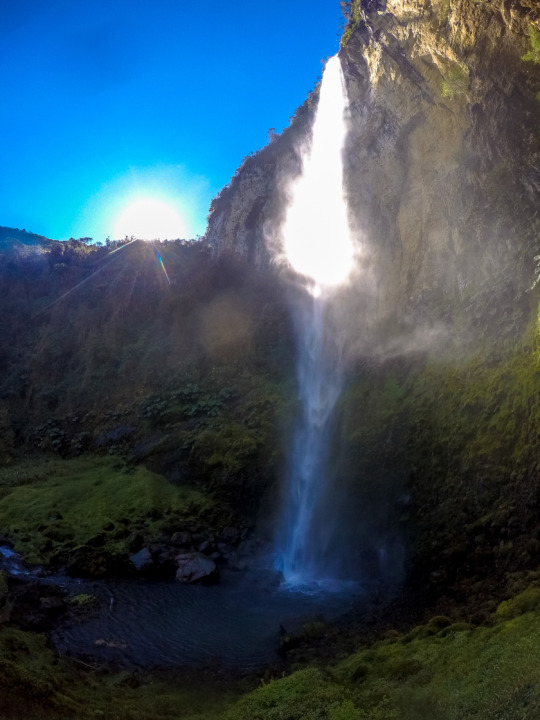
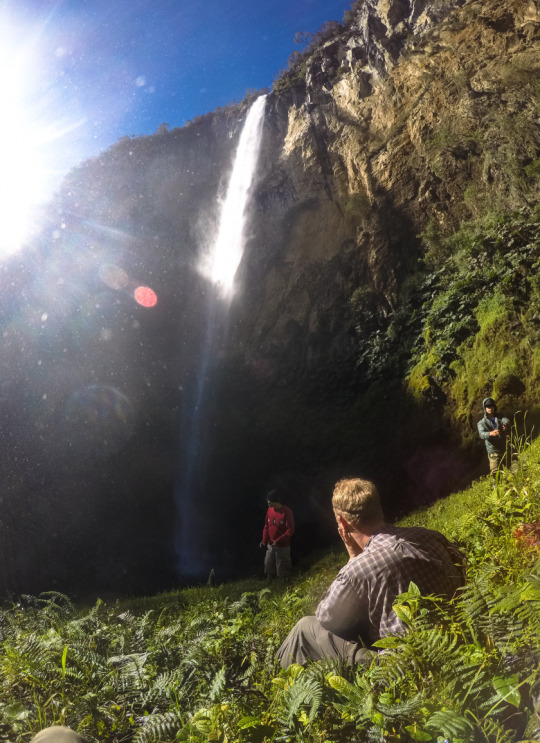
The damp clay soil banking the trail had the precise color and texture—tragically, not the flavor—of a rich, fudgy dark chocolate ganache.
Over two hours had passed by the time we returned to El Salto. Shouldering our packs, we passed a farmer digging a field by hand as we began to slog up the mountainside. The damp clay soil banking the trail had the precise color and texture—tragically, not the flavor—of a rich, fudgy dark chocolate ganache. The trail snaked back and forth across the slope, but for the most part carved straight up the mountainside. Foot traffic, cattle and water running along its length had slowly transformed it into a deep gash into which frustrated, motivated people had occasionally wedged timber in an effort to reduce the number of times plunging a foot into deep mud was a requisite, but cows, remember, are terrible people and had jacked up a lot of it.
DCIM102GOPROGOPR6073.
DCIM102GOPROGOPR6069.
DCIM102GOPROGOPR6086.
Muddied feet at last gained the pass at the ridgetop. Far beneath us, clouds obscured the view of distant Ibagué like dirty clothes hiding a dorm room floor—we’d see it eventually, but not without a day’s determined effort.
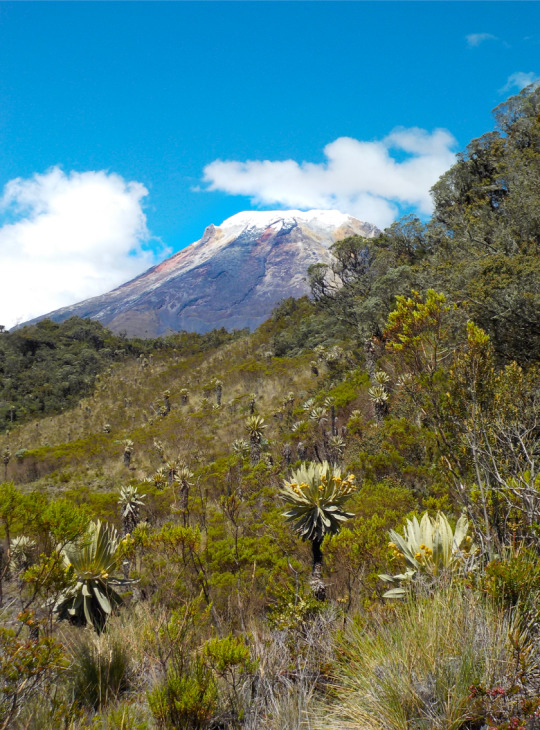
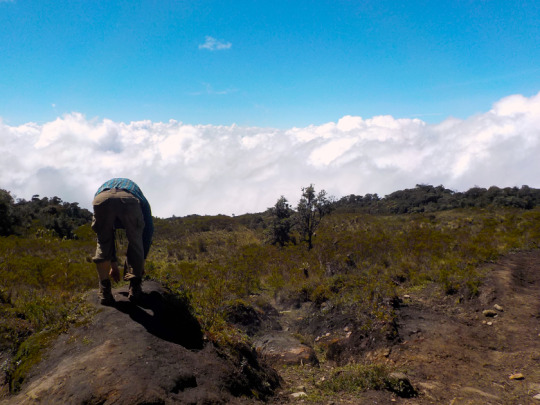

The hike from Ibagué had gained a reputation among online forums and blogs as an arduous, ugly descent but instead was one of the most beautiful hikes through cloud forest I’ve ever had.

Mountain descent to the famed city of Alternate Istanbul
DCIM102GOPROGOPR6104.
The other Istanbul
DCIM102GOPROGOPR6139.
DCIM102GOPROGOPR6126.
DCIM102GOPROGOPR6179.

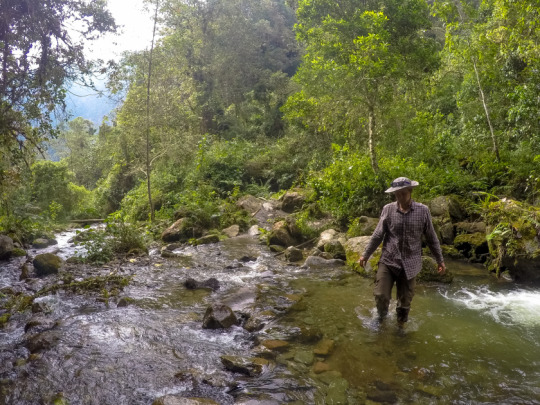
At the base of El Secreto Preserva Natural
As we entered Combeima Canyon, cloud forest occasionally gave way to steep slopes of coffee. Waterfalls slipped into the river far below and we saw fields and houses perched precariously on the few flat areas.

As we descended the slopes from Tolima a strange copper-colored stream crossed the trail from our left, eventually disappearing into the forest. Did it harbor some fascinating microbe from geothermal activity, or were these mine tailings from the illegal gold mine we’d heard hid somewhere in the hills above Ibagué ? Shawn thought geothermal. I wasn’t so sure.
DCIM102GOPROGOPR6242.
DCIM102GOPROGOPR6264.
After some time, we reached the outskirts of a town. Seeing a child playing among the barbed-wire clotheslines of a yard, we asked if we were headed in the direction of Ibagué. He responded, but with a heavy speech impediment we found difficult to understand. We continued to speak with him until his mother called him sharply from somewhere inside the house. Not long after, we came across another two children playing. Oddly enough, one of them also seemed to have some sort of mental or communicative disability. Their mother called them inside when she spotted us. I have no experience whatsoever in identifying developmental issues in children, but it seemed odd that two of three children we’d met had various conditions. I was reminded uncomfortably of the copper stream and the gold mine somewhere far above.
We spotted a man on the slope above us, who gave us directions at last. We confirmed them with a father and son busy at work planting a field that sloped steeply into the ravine below.
DCIM102GOPROGOPR6258.
DCIM102GOPROGOPR6265.
DCIM102GOPROGOPR6248.
Several more hours yielded the end of the trail. We caught a jeep in Juntas, the small town above Ibagué, riding past outdoor restaurants that looked to be a popular weekend spot for locals. Fun fact: A city just like Juntas was destroyed almost completely in 1985 when the eruption of Nevado del Ruiz (a volcano within sight of Tolima) unleashed a lahar of mud, ash and melted glacier.
One of the lahars virtually erased Armero; three-quarters of its 28,700 inhabitants were killed. Proceeding in three major waves, this lahar was 30 meters (100 ft) deep, moved at 12 meters per second (39 ft/s), and lasted ten to twenty minutes. Traveling at about 6 meters (20 ft) per second, the second lahar lasted thirty minutes and was followed by smaller pulses.
Over 23,000 people were killed, making it the fourth-deadliest volcanic disaster in recorded history and rendering the town of Armero a ghost town. Juntas, at the base of Combeima Canyon and the active Tolima, is at high risk of destruction. from Tolima. But anyways, here’s some recycled plastic art.
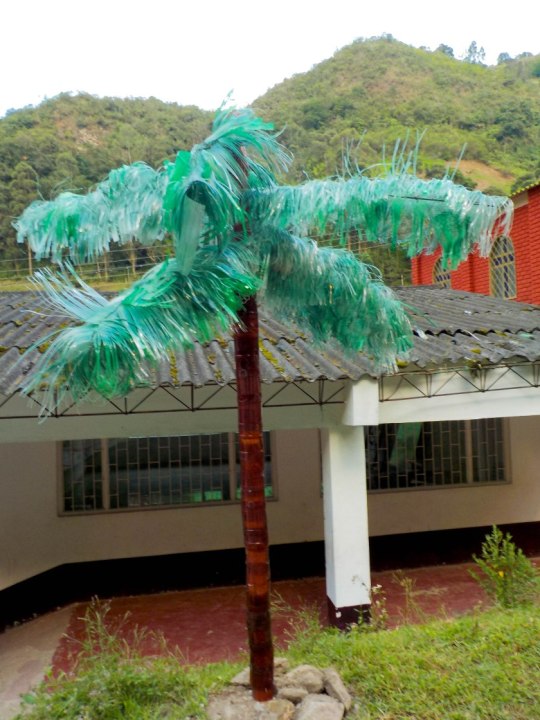

On the way to Ibague, we spoke to our fellow passengers, Colombians who had been doing a small modeling shoot in some abandoned buildings in the town where we’d joined them. We chatted amicably as we approached Ibagué . When we arrived, they gave us a general outline of the town and gave us a few suggestions of places they recommended and a few better left alone. We ate delicious food—reveling again in how little it tasted like Gatorade bars—until we remembered we had to catch our flight out of Bogotá later that night.
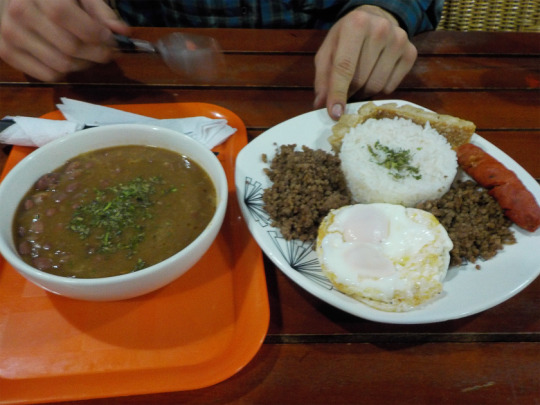
After a few frantic minutes locating a bus and purchasing tickets, we took turns showering in the public bathing rooms (maybe about 30 cents) of the bus terminal in an attempt to smell less like the mud and sweat of three days, using the small bar of soap to scrub some of the mud out of our clothes. After boarding the half-empty bus we made a beeline for the back and cracked open the windows, trying to set up our clothes and shoes in such a way that they might ride.
Though I’d like to pretend it is better, my memory is actually pretty bad, but I do remember this about our evening journey:
As the bus returned to Bogotá, the feel of the warm, humid wind drifting through the bus window and the rhythmic sounds of spinning tires on the wet highway wove a tapestry of sensation, wrapped us gently into sleep. Right. That’s beautiful prose and whatnot, but like much of the crap you read in travel blogs (some unintentionally here, hopefully mostly elsewhere)–overly romanticized, flowery and at least partly untrue. Luckily, oddly and surprisingly for us all I have a journal entry penned on this very bus, which in distressed letters scrawled thusly:
“The bus from Ibagué to Bogotá is stupid, smelly and shaky.”
An entry several hours from the plane from Bogotá to Lima elucidated.
“Remember the stupid smelly bus from Ibagué ? I couldn’t really get to sleep. A maniacal child boarded the bus and began to entertain himself by opening and closing the window, grabbing my hat while I was wearing it, and singing. Perhaps believing himself to be the next Colombian pop star, this [nascent Shakira] kindly treated us to his own renditions of mutated songs. [Alas], this lad’s caterwauling left something to be desired. His voice was the musical equivalent of placing thirty-eight gerbils in a centrifuge: intermittent garbled shrieks and a decided disregard for social norms.”
Shakira, Shakira.
Will Trade for Peanuts: Three Days in Los Nevados NP We wandered along the edge of the deepening canyon. With every step, the stream's chill, clear waters cut ever more deeply into the volcanic basalt that formed the ground beneath our feet.
#adventure tourism#backpacking#colombia#Ibague#Los Nevados#national parks#paramo#rural tourism#Salento#trekking#Valle de Cocora#volcano#Volcano tourism
1 note
·
View note
Photo










Salkantay till Machu Picchu, dag 1 och 2.
Klockan 04.15 ringde det på dörren och vi blev hämtade för att bege oss till starten för femdagars vandring mot Macchu Picchu. Vi var spända på vilka personligheter som skulle ingå i gruppen och höll tummarna hårt för bättre lycka än förra vandringen. Det visade sig att vi blev lyckligt lottade och stämningen var på topp redan vid första frukosten. Det var framförallt två tjejer från Australien och en tjej från England som bjöd på sig själva och spred en positiv stämning i gruppen. Vi hade också sällskap av ett svenskt yngre par från Växsjö. Det var trevligt att få prata svenska igen. Men vi fick passa våra tungor så vi inte sa något olämpligt. Vi har vant oss vid lyxen att prata om vad som helst utan att bli förstådda. Två andra i gruppen som stack ut var ett franskt lite äldre par som inte pratade ett ord engelska. Inte heller var de förberedda på att de skulle vandra. De blev höjdsjuka, surade och tog sig mest fram på häst. Sen var det en fruktansvärt störande tyska som hade ett behov av att hävda sig var och varannan minut. Man kan säga att hon var lyckligt lottad att hon inte förstod svenska för det kom en och annan groda ut från våra munnar om henne. Totalt var vi i alla fjorton stycken i gruppen. Första dagen var lätt. Vi gick cirka två timmar innan lunch och därefter en timmes vandring upp till en sjö på 4200m. Vi var på gott humör och glada över fint väder. Campingen första natten låg i en helt magisk dal. Snötäckta berg och glaciärer omringade oss. Det var också fullmåne så man såg konturerna av de höga bergen även efter solen gått ner. Dag två väcktes vi återigen tidigt. Efter en snabb frukost väntade vandringens tuffaste dag. Denna dag hade jag (Erika) bävat för innan, för den skulle bestå av fyra timmar brant uppför och fem timmar nedför. Mina knän såg inte alls fram emot nedförsbiten och inte heller att gå i nio timmar. Med viss oro över hur det skulle gå traskade vi i alla fall iväg från campingen på bra humör. Morgonen var så vacker med strålande sol och vi tackade innerligt för det. Det gick bra för oss, det blev tydligt att vi acklimatiserat oss till höjden vid det här laget. Vi stack ifrån det andra som kämpade hårt med andningen. Peter var helt galen denna dag, ingen förstod hur han bar sig åt men han nästan sprang upp för backarna nästintill jämsides med hästarna... Jag hade ett väldigt sjå med att hänga med men en jävla anamma hann jag nästan ikapp. När det andra kom ifatt upp på bergstoppen stod det bara och skakade på huvudet och undrade hur vi burit oss åt. Antar att de många vandringarna gett resultat på konditionen. Nedför fick jag dock ta det väldigt lugnt. Min smärta från knät började sprida sig ner till muskelfästet vid ankeln. Det var tufft men med stavar och Voltaren lyckades jag ta mig ända fram. Väl framme fick jag en undersökning av en amerikansk fysioterapeut som var med i gruppen. Hon uteslöt meniskskada vilket var skönt att höra. Hennes slutsats blev att muskelfästet blivit överansträngt och inflammerat. Hon berättade också att det är vanligt att kvinnor är för svaga i sina höfter. Denna svaghet leder sin tur till belastning på nästa ställe. Jag har haft känning i höften i princip varje vandring, så det låter rimligt att inflammationen spridit sig vidare neråt. Helt enkelt börjar det bli dags att vila och därefter träna upp sig lite bättre framöver. Kvällen spenderades med sångspel, ordspel och trerätters. Alla glada och nöjda över dagens insats.
1 note
·
View note
Text
Bagan
From Yangon to Bagan, we took a 10 hour sleeper bus from 8pm arriving at 6 am. The bus had reclining seats with complimentary pillow, blanket and snacks. It wasn’t bad for around 19 dollars each. I chose not to use the toilet for the whole time though as it was blocked apparently! We shared the coach with many other tourists, we got chatting with a guy from London travelling alone and a couple, the guy from London also and his partner from Brazil.

The bus drivers within Myanmar are crazy, they literally drive at high speeds round mountainside bends in the pitched black, no street lights to guide them. I woke up from my sleep during the mountain ascent and I did get a little anxiety, that they would tire and we would swerve off the mountain edge. However because it was dark I couldn’t see an awful lot so it made it a little less obvious how close we were to the edge. The ride was bumpy and long.
As the sun started to rise we arrived at the entry point of Bagan, we each had to pay an entry fee, some sort of tourist tax, usually the case in the third world countries. Unaware of this we each had to scramble together the change we had in our backpacks. Bagan looked like a ghost town this early on, dusty roads and mist sitting above the temple tops.
Bagan is an ancient city and a unesco world heritage site. Located within the Mandalay region of Myanmar. Bagan is one of the worlds greatest archeological sites, a site rival to Macchu Picchu and Angkor Wat.
Rising from the green landscape are temples, hundreds of them, beautiful- the most beautiful we had ever seen. They were built between 1057 and 1287. Bagan has been swept with earthquakes. Only 2230 of the original 4450 temples survived. Temples were still been rebuilt at the time we visited. A legacy of the buddhist belief, that to build a temple was to earn a merit.

Arriving at 6 am to our hotel meant we had to wait until the room was clean. Exhausted from our broken sleep on the bus. When we finally checked in we spent a few hours catching up on lost sleep.
Our plan for Bagan was to ride in a hot air balloon above the temples. It was our second attempt and different location to try but due to the weather it meant we was unable to fly and the backlog of rebookings meant we did not have the time to wait. Gutted, but we tried not to dwell on it to much.
We rented some electric mopeds to explore Bagan. We met up with our friends from the bus, we chose to watch the sunset from the top of a temple. We visted the Shwesandaw Pagoda. A Buddhist Pagoda that contains five terraces, topped with cylindrical stupa which has a bejwelled umberella. There are steep steps at the front which take you to each level or all the way to the top. You had to climb in bare foot in respect for the Buddhist beliefs. The girl we was with was afraid of heights so it took a little longer than usual to get to the top. Once we got there, wow what a view it was of all the surrounding temples and green scenery. The sunsetting in the distance. There were many tourists but it was still worth a visit.



After the sunset, we descended the steps back down. At the bottom were many local children selling their hand drawn pictures of Bagan. It was hard to refuse, so we did buy some overly priced pictures. Cute smiles and good speaking English, they deserved a little treat.

We found a local restaurant within the township were we had some cheap grub and beers.
The next day we took the scooters for some exploring around Bagan to see the many different temples and scenery. Along the way we come across a restaurant/bar, alfresco style hut called ‘Weatherspoons’. This was amusing, the English guy could also relate. We couldn’t miss opportunity for a pint in Wethers, there is literally one everywhere you go!

We visited the Kayan people in Bagan. We wanted to see the Kayan Lahwi women, the women that wear brass coils around their necks. The coils appear to lengthen their neck, it is theorised that the coils originate from the desire to look more attractive. Women have much slender necks than men do. The brass coils can weigh up to 20kg, making working in the fields difficult and painful. The Kayan people say this custom was originally established to make women actually less attractive, protecting them from other tribes trying to kidnap their women. Nowadays they are worn to preserve their cultural traditions. Girls begin to wear the coils at around 5/6. Depending on their wealth, the price of each coil use to be around 2 us cents now they cost 250 dollars each. The younger generation prefer not to wear due to antiquated practice. However in the Northern parts of Thailand, tribes see it as a tourist attraction and money making business so still continue this practice.


Our final day in Bagan we visited Mount Popa. An extinct volcano 1518 m high. South east of Bagan, a couple of hours in a mini bus to get there. There is a temple at the top, climbing many flights of stairs in the midday heat to get there. As you climb the stairs you are greeted by many cheeky monkeys that steal tourists belongings and attack for food. They know where to hang out! The views from the top were pretty magnificent but the temple itself was nothing special and crammed with other people. Enroute back to the hotel we stopped for traditional Burmese tea.

Our next stop on Myanmar was Inle Lake, we chose to take another sleeper bus to get there...
0 notes
Text
My trip around the land of the Incas and much more
After spending over two weeks in Ecuador’s amazing sceneries I headed back to Peru. In September 2016, I headed to Cusco and it’s amazing secret valley. I spent just under 10 days there and loved it. This time round I decided to do the coastal areas of Peru. With these two trips I managed to cover quite a bit of Peru; just the jungle remaining. Therefore, I outline below these two trips and their itineraries. Any questions just ask!
Cusco, the Secret Valley and Machupicchu
Arrival day: We flew straight to Cusco. We landed late at night and made our way to our hostel Cuscopackers. We then headed to Morena, this amazing restaurant just by the main square. We ate ceviche and a piece to complement - truly a must! It was then time for bed as we were truly exhausted.
Day 1. The next day before heading out on any tour we bought the Boleto Turistico that includes entry to 16 archaeological and cultural sites - S/130 (£31), valid for 10 days. We bought this at Avenida el Sol 103, office next to iPeru office, or you can buy it at entries to the sites. We then booked our tours with Hotel Ruinas agency before doing a Free Walking Tour (http://www.inkanmilkyway.com/free-city-tour-cusco-10-am) which started at Plaza Regocijo/Kusipata, in front of The City Hall (look for The FTF logo on the Yellow Vest). These leave at 10am/1pm/3.30pm and last 2.5-3 hours.

Cusco City Centre
Followed by lunch at Jack’s Cafe. In the afternoon of this first day we did: the Cathedral, the Temple of the Sun or Qoricancha, Tambomachay, Sacsayhuaman, Q’enqo, and Pucapucara. The tour included transportation and group guide, entrance to the cathedral and Qoricancha; Quoricancha and Sacsyhuaman. That evening we went to the Pisco Museum for some Pisces and antichurro.
Day 2. On our second day we did: Pisac, Urubamba then to Ollantaytambo. We climbed the ruins in Ollantaytambo and then, on our own, Pinkuylluna Mountain granaries (Qollqa). This is free, and it closes at 4pm. It is more or less 2 hour round trip. It is a steep climb but with a great view of Ollantaytambo. The entry is a bit hidden; it’s through small door on Lare Street up some narrow steps. That evening we ate at one of the restaurants by the main square some Cuy.
Day 3. We spent two nights in Ollantaytambo so on the first full day, our third day of travel, in Ollantaytambo we booked a taxi that took up to Moray and Maras - also a must! We ended the day at Chinchero; a town full of textiles.
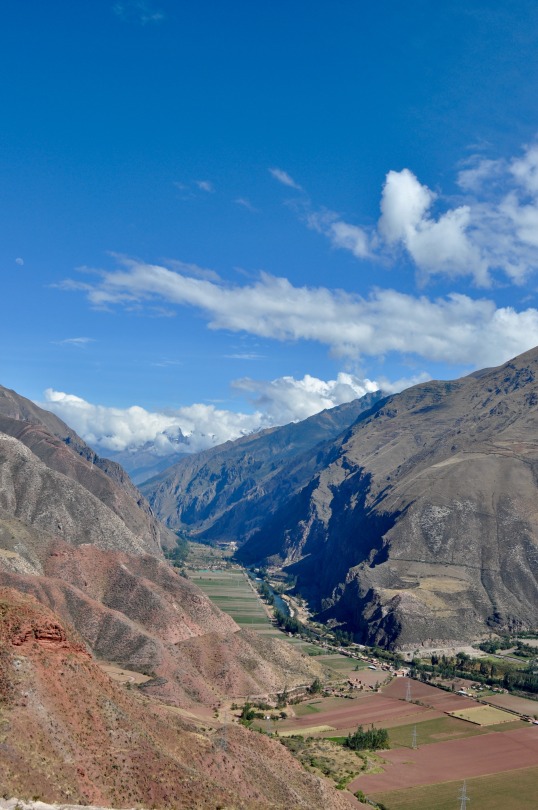
Sacred Valley
Day 4. The following day we had booked ourselves on an early train to Machu Picchu that arrived at 9am into Aguas Calientes (the town of Macchu Picchu). I will advise you now to book your Machu Picchu entrance tickets and the train early on (we booked it two months in advance). We got to Aguas Calientes around 9am and headed up on the bus. Quick tip: buy the tickets for both days right there and then at the booth on the side of the road as the queues get big unless you think you will climb up there. We did the Sun Gate and the Inca bridge on this first day. We also stayed until the park’s closing the sunset was truly incredible.
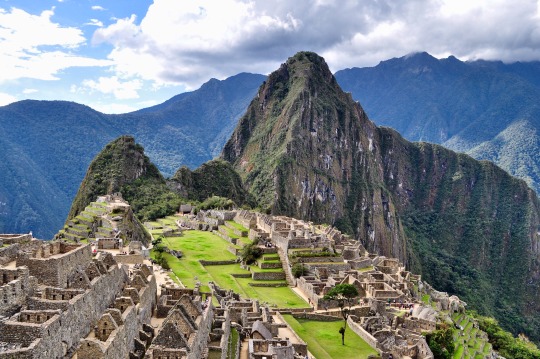
Machu Picchu
Day 5. The second day in Machu Picchu started really early - aim for 3am queuing. That second day we left on the last train to Cusco so we trekked WaynaPicchu at 11am but would recommend booking an earlier slot as the longer route closes if you go later. We just managed to get there in time and sweet talked one of the guards to let us through. We enjoyed the rest of the day and headed back down before our train. We chilled at La Boulangerie de Paris; this amazing cafe on the other side of the river to the train station that is run by this French guy. Amazing stuff. Also before getting to Cusco that evening ask you hostal or hotel or arrange a taxi to pick you up as the Cusco station is far from the city centre. We then headed to our hostel - Millhouse, which is great and super well located. We stayed two nights.
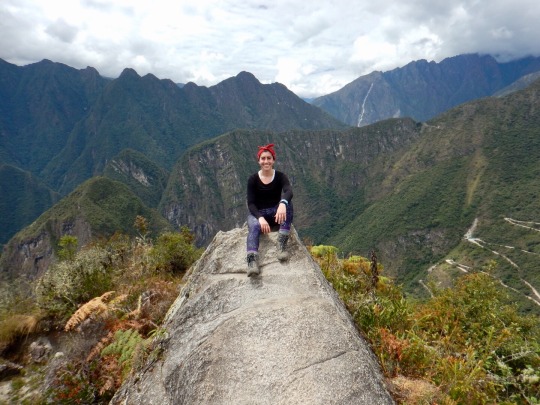
WaynaPicchu
Day 6. The next day we took it easy and walked around San Blas area; Mercado San Pedro; and went to a few of the museums included in the Boleto Turistico.
Day 7. On the Friday, we climbed Rainbow Mountain...in the snow, rain, hail, fog, and freezing cold. Quick tip: Rainbow Mountain should be done last as its the highest you will get to (5,009m). To celebrate getting to the top despite all odds we had dinner at Uchu Peruvian steak, which was super yummy! We then headed to Prisco Museum for some pisco sours. They had their anniversary that evening and were doing 2 for 1 deals which is a recipe for disaster and a great night. We then left the next day around 12.
SACRED VALLEY CRIBSHEET…for those not interested in the essay above or those with little time...
For Restaurants:
Cusco: Morena; Jacks cafe; Nuna Raymi; and definitely Uchu Peruvian steak. There is also: Greens Organic; Qucharitas icecream; Cioccilina; Restaurant cafe bar pucara; The meeting place - waffles; Cafe loco.
Ollantaytambo: any on the square;
Aguas Calientes: all quite expensive but a must is La Boulangerie de Paris.
For Hostels/Hotels:
Cusco try and book Millhouse. On our first two nights in Cuzco Millhouse was booked out so we stayed at Cuscopackers which is good but a bit far from the centre. There is also Ruinas Hotel for those with a roomier budget.
Ollantaytambo: El Bosque Backpackers which is good and super close to the train station which is a bonus in the morning.
Aguas Calientes: Taypikala Boutique hotel. Make sure you contact them for someone to come and grab your bags at the station so you can head straight to Machu Picchu without having to detour to the hotel.
Travel:
PeruRail sells the trains to Aguas Calientes.
To do:
Cusco: walking tour and museums; the Cathedral, the Temple of the Sun or Qoricancha, Tambomachay, Sacsayhuaman, Q’enqo, and Pucapucara
Pisac; Urubamba; Ollantaytambo (same day)
Moray and Maras (same day)
Must eats:
Savoury:
Ceviche: diced fish with lime with onion, chilli, sweet potato, corn and sometimes seafood
Anticuchos: grilled skewed meat, street food,often cattle hearth
Cuy: guinea pig
Salchipapa with sausages and potatoes
Lomo Saltado: stir fried beef
Papa Rellena: stuffed potato
Aji de Gallina: chilli chicken
Chicarrones: pork served with fried sweet potatoes
Rocotto Relleno: stuffed peppers super typical of Arequipa
Chupe de camarones: shrimp soup super typical of Arequipa as well
Chifa: Peruvian version of Cantonese-Chinese food
Sweet:
Alfajores - baked pastry
Turron - anise and honey nougat
Lucuma - cooked fruit in dessert - popular in juice, ice cream, shakes
Mazamorra - jelly with purple maize
Picarones - sweet friter, pumpkin and molasses
Tejas - candy filled with manjar blanco or choc
Suspiro Limeno - milk, egg white, port, cinammon
Drinks:
Pisco sour - pisco, limes, sugar, alcoholic
Chicha de Jora - yellow maize, alcoholic
Inca Kola - yellow soda
Chicha Morada - purple maize, sweet, non alcoholic
Now onto my second time in Peru - the coast!
Lima, Huaraz, Paracas, Huacacchina, Arequipa & Puno
Day 1. From Cuenca, Ecuador I got on the night bus (the company I got was Azuay) to Chiclayo, Peru. We arrived on the border within 4 hours into the trip. The border crossing took two hours. You go through the Ecuadorian side then back on the bus and then out of the bus and through the Peru side. Then onwards past Mancora and Piura to end at Chiclayo around 11am ish. I went straight to the main bus station (make sure to grab a yellow taxi and no other and agree on the price before jumping in) to find a ticket to Lima. I left on the same day to Lima with Allinbus at 6pm but there are earlier buses. I arrived in Lima at 6am. Again a 12 hour ride. Be warned that there is nothing to do in Chiclayo and it is not safe so if you can fly to Lima. When you get to Lima then think about getting to Huaraz as this seemed to be the easiest and quickest way around.
Day 2. After arriving in Lima at 6am I grabbed an Uber and made my way to Catalina’s place (friend of a friend). Remember to get out at La Victoria stop if you are staying near Miraflores which I recommend. I then went to Claro to get a sim (S/35 for sim plus 30 days of 3gig plus unlimited whatsapp and calls). From there I went to Huaca Pucllana which is an awesome archaeological site and from there to AMANO museum of textiles. My day ended walking at the malecon. I also ate at Punto Marisko (good priced ceviche and they have them around the city).
Day 3. Today the day started early at 9am in the centre of Lima. I grabbed an Uber which cost me USD4 approx., which is more recommended and cheaper than any taxi on the street. I got to plaza mayor and walked to the Convento de Santo Domingo followed by the Basilica and Convento of San Francisco and did the tour of the catacombs. The entrance is S/15 and you have a tour guide for 45 minutes. The Arab inspired dome and the courtyard is absolutely stunning. Pity no pictures are allowed inside whatsoever. From there I walked to the Church of San Pedro and then the Torre Tagle Palace. I did not manage to get inside the Tagle Palace as its only open to the public on Saturdays and Sundays, and if that happens to you just look up and admire its amazing balconies from outside.
If you end up doing all of this by lunch time you must eat at L’eau Vive del Peru which is in front of the Torre Tagle Palace. This is a house that was renovated and now the sisters of the household open its doors for lunch and dinner (lunch from 12:30 to 3pm and dinner from 7:30 to 09:30 pm). The proceeds of the meals goes to serving food to the poor. The meals are well served and although they have a la carte options the meal of the day is a three course for S/19. I then walked down Jirón de la Union street which is a pedestrianised road and arrived at Plaza San Martin where I went inside the Gran Hotel Bolivar Lima, which once hosted presidents and very important people; it was one of the first luxury hotels in the area. Also walk a bit further on to admire the Club National a members’ only club with astonishing architecture.
If by this point you are a bit tired and want a sit down and/or a desert please make your way to Pastelería San Martin (Portal de Gonzales 991) on the opposite side of the Plaza to the Hotel and order their Turrón de Dona Peppa. It’s absolutely delicious and a Lima thing. From there I walked down to the Museum of Art of Lima (the MALI). The entrance is S/30 and you can and should download the MALI App from your App Store (just search “MALI App”) and there you can see each room and listen to the explanation of various paintings and sections of the museum. The museum itself is not enormous but you can expect to spend around 1-2 hours there. The MALI also has an adorable cafe and sitting areas so make most of it plus it gives out to quite a nice park. By then it was 4pm and so I headed home by taxi.
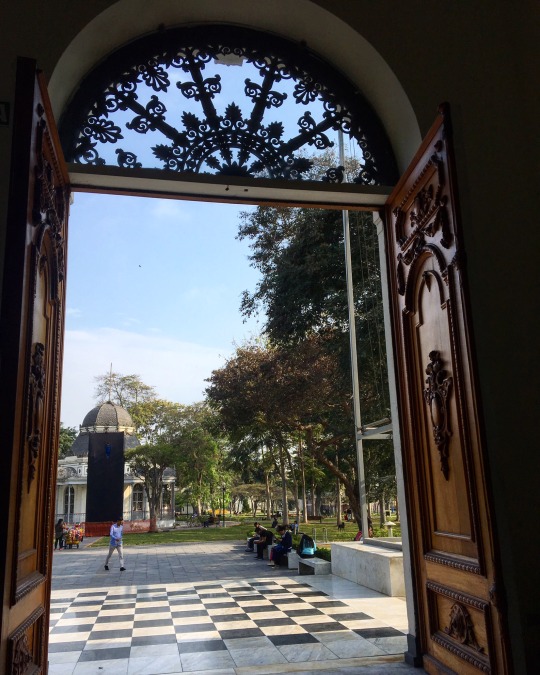
MALI
Day 4. On my third day in Lima, I went for a morning walk to the street Petit Thouars where all the artisan markets are. I would recommend you walk all the way past the electronics retail shop called Hiraoka and then enter the Indian Market Miraflores. Then you can walk around this market then down the road as there are many others although this is the largest. Plus you want to figure out where you have the best prices. Baby alpaca numbers range from S/100 to S/200. Then you have your alpaca jumpers at S/40 to S/50. You can also find silver of all kinds. You can find rings at S/50 with very nice stones to small earrings at S/20. Then you have everything in between. I would recommend you look around before buying anything. If however you are going to Cusco then stuff there is slightly cheaper. This took me around 2 - 3 hours. Then at 1pm we headed for lunch at a buffet called Chifa Internacional on Av República de Panama. It’s an all you can eat with Peruvian food and Chinese food. Worth it!
Day 5. Trip to Huaraz. I would recommend that you leave your stuff at your hostal/hotel in Lima so you can travel light to Huaraz. I bought the overnight bus to Huaraz leaving from Javier Prado (which is much closer than the Terminal Norte especially if you are staying in the Miraflores area which I recommend). I chose to leave on a Wednesday night, arriving at 6am in Huaraz on Thursday and returning at 10pm on Saturday night, arriving in Lima at 6am on Sunday. The bus company is called Cruz del Sul and each way cost me S/90. This a bit more pricey than other providers but they have a really good rating and plus you would spend twice as much getting to Terminal Norte (where most providers leave from) than Javier Prado. The hostal I booked was Alpes Huaraz which is very well located and super well priced. I then booked my day tours with the hostal themselves which is much cheaper than anywhere else - S/35 max each. As I arrived on the bus at 6am and the tour to Chavin left at 9am so I was out of the door just before 9am and spent my day out at the archeological site which is incredible. Chavin was a civilization more than 3,000 years ago. Definitely a good choice to climate to the Altitude and honestly an impressive site. Once back I went to get some food at the market just down the road.
Day 6. On my second day in Huaraz I headed to Laguna 69 (it's name comes from some counting of seismic movements and earthquakes in the region). The trek is through beautiful forests, sights of far away waterfalls and a couple of smaller lagoons so it's beautiful. However, don't be fooled. The trek is 8km each way nd most of which, apart from the first 40 minutes or so and a bit in the middle, is a steady incline. So it's flat, up (zigzagged), a bit flat ish, then zigzag. I made it in 2 hours and there were about 7 other people up there with me. Everyone else arrived between 2.5 and 3 hours. I managed to then chill for over an hour and made my descend in 1hr40 ish. So although beautiful and totally worth it, be warned. I had no issues with the altitude but some did. You go from 3,870m to 4,604m in 2 hours. Double breath in and one out helps me just make sure you don't hyperventilate. I also took coca tea in my flask, gatorade, water, snacks and lunch.. Make sure you take water and food for lunch so the night before I bought all of this. The trek can take anything from 2 to 3 and a bit hours. The trek is demanding and fairly uphill but simply beautiful.

Laguna 69
Day 7. Today wake up at 8pm for 9pm leaving for Pastoruri Glacier. We stopped at a few places to see the lakes as well as the puyhual rumondi plant that grows here. The trek up was the last thing we did. Started around 12:45noon and we had 2 hours to be back. I made it in 49 mins and in comparison to Laguna 69 it's really easy. It's beautiful. We were back for 6 ish. Shower and bus back to Lima at 10pm.
Day 8. Arrived back in Lima at 6am. I then went into town to speak to PeruHop (this company that does bus routes and I would super recommend it!). I then went to visit the Malecon, then the Barranco District (unfortunately the Pedro de Osma museum was closed but even the outside was worth seeing it) then Chorrillos and El Olivar Forest to end the tour at this amazing café - lá Bonbonniere (http://www.labonbonniere.pe/carta/postres/). So yum! If you go order Guarguero and the hot chocolate!
Day 9. Today I headed out early and was at Museo del Larco at 9am. This is an amazing museum. It is near the archeological museum but I was so taken by it that I spent nearly three hours there. The actual collection is not huge but super interesting. A lot of Nazca (1-800 AC south) and Mochica (1-800 AC but north) stuff as well as Chimu (1300-1532 AC) with amazing gold stuff. The gardens are stunning and one could just sit and chill there forever. In the afternoon the sun came out so I off to the malecón for a walk!
Day 10. I had bought the PeruHop route from Lima to La Paz with first pick up at 6:30am at the Dazzler Hotel on Prado. You can get picked up in various spots in Lima, which is super awesome. The bus is clean and there are all sorts of travellers on. Backpackers, more luxury and everything in between.
The first leg of the route was to Paracas but we first stopped at Pachacamac or more like drove slowly past it. Then the Chincha Tunnels. This place is beautiful but the tunnels built for slave black market are terrible. From there another hour to Paracas. In Paracas we had lunch at the Paracas Restaurant - on the top floor where there are some amazing views. As a PeruHop traveller you get 20% off the food there although food is a bit pricey (s/31 for ceviche with discount). Then we went to the national parks in buggies and watched the sunset. Then I was back at the hostal for late afternoon. I stayed at Kokopelli Paracas hostal (s/32 for 4 bed dorm - PeruHop also gets discount there and s/32 was the discounted price) and then dinner at Misk'i - I had the quinoa and avocado salad which was well served and super nice (at s/20). The food at the hostal is cheaper for sure.
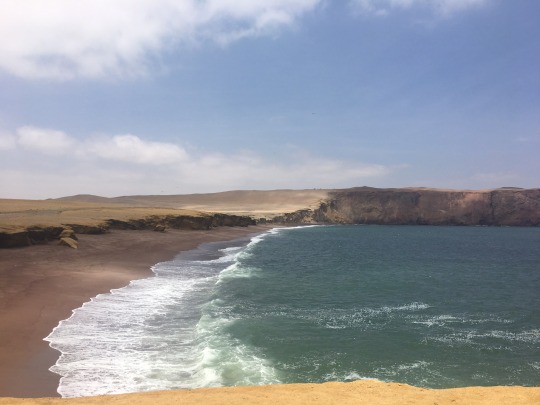
Paracas National Park
Day 11. We set off at 10:45am from Paracas to the national park (you also have the option to do the islands (Islas Ballestas) but if you have done Galapagos it is not really worth it). We then headed to Huacachina arriving around 2pm. At 3:30pm we were booked in for the buggy rides and sandboarding. If you want a driver that is a bit crazier ask for adventure and tip well. We then watched the sunset at the top of the dunes. Followed by dinner. Absolutely amazing day!

Huacacchina
Day 12. I decided to do the Pisco tour which isn't that worth it. Maybe should have gone with the guys to Nazca for the flight. When back chilled by the pool then had drinks with the guys and waved them off. I then moved hostel from Bamboo to Carola Hostal. This is more party but has a pool and my 10 bed dorm only has four people with me.
Day 13. We headed out early to Nazca, and after two hours we arrive in Nazca. We then waited another two hours for our flight. Definitely worth it if you have the time and the cash (USD60). We then waited until 6pm so four hours to the overnight bus to Arequipa. Here we go!
Day 14. Arrived in Arequipa at 6am after a hectic trip. There were heavy winds and issues on the roads. We arrived at the Dragonfly hostal not much later, dropped our bags, had breakfast and made it to the free walking tour of the city that left at 9:30am. The meeting point was by the Chicha restaurant near the Monastery. The tour took 2.5hrs. It was good but the tour guide’s English wasn't great. The other option was to wait until 10am in the same spot and do the Inka Milky tour (which also does a 3pm slot). After that I checked in, showered and went for a walk. I grabbed some food first at La Lúcha sandwich (the traditional which I highly recommend) near plaza de armas then some Queso helado and then bed.
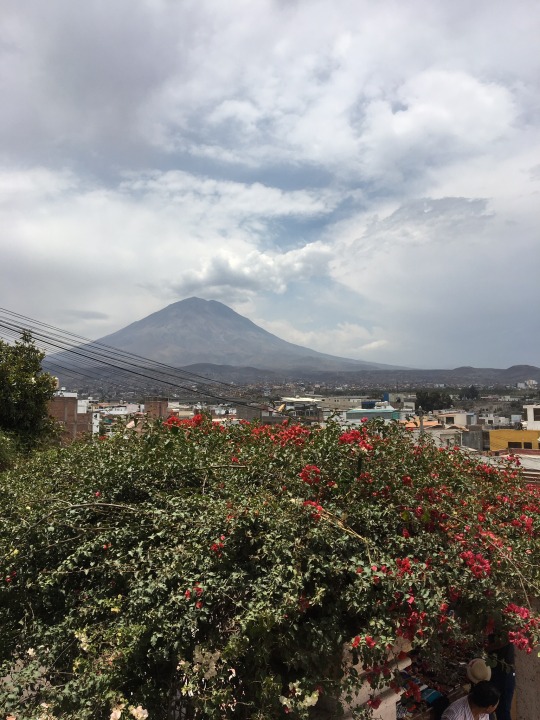
Arequipa
Day 15. Wake up at 7am for breakfast and some admin. At 9 I headed to the Museo Andino just round the corner to see juanita (this frozen child from inca times) named after the American who found her. The tour is over an hour and super worth going with a guide (tip basis). Afterwards back at the hostal for some downtime until 11 ish when I headed out to Yanahuara district to see their church and the viewing point. I walked all the way there and the walk itself is a nice chilled walk - about 20 mins. Afterwards it was lunchtime and I headed to a picanteria called La Nueva Palomino with great food. Then uber back to the market to get some fruit. This was already 2pm. Around 3pm I headed to the Monastery. I would also recommend getting a guide here (I paid s/20). If you are in Arequipa on Tuesday or Wednesday do both day and night at the Monastery - meant to be amazing at night as well. I was looking forward to dinner at La Trattoria de la Monasteria just outside the Monastery but it was closed - next time.
Day 16. Early wake up for the bus to Puno. After leaving Arequipa at 5am we stopped for breakfast at 11am then again at the highest lake in Peru for pictures a bit later. We made it to Puno for 13:00. Once arriving in Puno in the afternoon I had a quick lunch then headed to the 2 hour tour of the Urus islands. You can a 2 hour tour, or a full day, or two days with a home stay. I found that the two hour was interesting and we saw the islands and the people. Perhaps a full day would mean you see a bit more.
PERU COAST CRIBSHEET...…for those not interested in the essay above or those with little time...
Restaurants:
Lima: Punto Marisco; L’eau Vive del Peru; La Bonbonniere; Pastelería San Martin (Turrón de Dona Peppa); Chifa Internacional on Av República de Panama
Huaraz: street food (by the supermarket)
Arequipa: Monasterio, La Lucha,
Hostals:
Huaraz : Alpes Huaraz Hostal
Paracas : Kokopelli Backpackers Hostal (where I stayed); Los Frayles Hotel; Paracas Backpackers Hostal (all of which have discount with PeruHop)
Huacachina: La Casa de Bamboo (where I first stayed and also has PeruHop discount); Carola Lodge (where I also stayed); Bananas looked pretty good too. Be warned that Carola is more a party hostal. Bamboo has no pool.
Arequipa: Dragonfly Hostal (where I stayed); Casa de Avila; Flying Dog; Wild Rover (party hostal) (all of which have discount with PeruHop)
To do:
Huaraz: Laguna 69; Chavin; Pastoruri Glacier; and various other walks
Lima: AMANO museum; MALI museum; Huaca Pucllana; Convento de Santo Domingo; Basilica and Convento of San Francisco; Church of San Pedro; Torre Tagle Palace; Plaza San Martin; Malecon; Barranco District (Pedro de Osma museum); Chorrillos and El Olivar Forest
Paracas: National Park
Huacacchina: Oasis (sandboarding and buggy)
Nazca: Nazca lines
Arequipa: free walking tour; Monastery; Museo Andino
Puno: Uros islands
Thank you Peru!
Your world. My world. Our world.
#peru#lima#machupichuperu#paracas#huaraz#arequipa#puno#travel#travelvision#Vision#visionworld#yourworld#myworld#ourworld
0 notes
Text
FUERZA ANDINA
Before we walked into Andina on a rainy Saturday afternoon in London, the two things we knew about Peru were Macchu Picchu and Ayahuasca. According to the founder of this bar and picantería (a lunch eatery originating in South America), Martin Morales, Andina means a strong woman from the Peruvian Andes. Andina is located five minutes away from Shoreditch High Street Station. We think Andina is definitely worth battling off the bearded hipsters and pop up stores of East London to get to.

(Photo from Google Maps)
SEATING
There are a variety of seating options to choose from - although we were not awarded this luxury due to arriving at a busy time. The upper floor is quite a small and restricted area; there are tables and also high stools by the chef's’ counter where you can watch the food being cooked before you. There is also a downstairs with more ambient lighting and a larger amount of tables and seating. We were placed by the chef which proved to be an interesting experience as we sat mesmerised watching the chef massage red meat.
vimeo
OUR ORDER
The portions are small due to Andina being a Picantería, so the recommendation is to buy three dishes per person.
1. Camote pancakes (Sweet potato pancakes, spiced chancaca honey, coconut whipped cream, seasonal fruits and dry physallis).

The sweet potato added a richness to the pancake which was fluffy and more-ish. The coconut in the cream wasn’t as strong as anticipated. Overall, delicious.
2. Thick-Cut Chips with Huancaina Sauce (cheesy amarillo chilli sauce)

All we ask for in chips is that they are crispy on the outside and fluffy on the inside. These chips exceeded our expectations. After a quick google search of what amarillo sauce was (basically to check whether it had alcohol in it), we proceeded to devour every morsel of this cheesy goodness.
3. Chicharrón de Camarón (deep fried baby prawn, seafood oil, acevichado-garlic cream)

Probably our least favourite dish. The garlic cream tasted more like seasoned yoghurt, and we didn’t anticipate how baby these baby prawns would be. Definitely not great value for money despite the fact that there were so many of them.
4. Torrejas de Plátano (ripe plantain fritters, fresco cheese, chancaca honey and coriander)

The fritters were rich and filling, but the fresco cheese overpowered the dish.
5. Chicha Beat juice: beetroot, purple corn, carrot, apple, lemon, ginger

A refreshing and cleansing juice, with the right balance of sweet and savoury for the incredibly rich food we had ordered.
6. Fuerza: quinoa, apple, cinnamon, milk, maca

Our favourite part of the whole dining experience. Fuerza tastes like a hug in a cup. We could have come to Andina and had the Fuerza alone, and we would have been satisfied. It tastes like a sunday morning in bed with the sun shining through your curtain windows.
TOILETS
Overall we would recommend Andina’s bathrooms to a friend. There were enough of them - it was a gender neutral bathroom with around 6 separate cubicles for men and women. There was no negative or positive smells in the bathroom as a whole. The cubicles themselves had enough space to move around in with a mirror on the back of the door.
TO CONCLUDE
Andina was an energetic and friendly place to eat in. For those who do not enjoy being in places that serve alcohol, we wouldn’t recommend it. The main room upstairs hosts a bar.
The waiting staff were helpful, and service was fast considering we came in around 1pm on a Saturday.
We spent £32 in total. As it is located in an increasingly gentrified, up-and-coming part of London, the prices are high. For example, the pancakes cost £9 for 2. Our liquid gold, Fuerza, cost us £4 for a cup. As you can see from the photos, the sizes were small. It is an expensive place to eat for many.
OUR RECOMMENDATION: MUBÃH (neither forbidden nor recommended). But we would definitely encourage you to go in and grab a cup of Fuerza!
1 note
·
View note
Text
Cusco/Macchu Picchu - June 31 - July 3
Sammya and I flew to Cuzco (much smaller airport than I expected) and the whole crew from the Panamerican games got into a bunch of vans and went to our hotel- sits up on a hill looking over the Cusco valley so it has a beautiful view but is pretty far from the main city center. Took a hot bath and Sammya and I had a nap (in this huge suite that turned out to be the wrong room- I was off by one and the door wasn’t locked..). Then I got a collectivo to the plaza de armas to print out our Inca Rail tickets. Cusco in general has a lot of brownish-red brick and beautiful architecture (including some really stunning buildings around the plaza and a sort of castle-looking church that’s built on an old Inca temple site. The city center is charming and pretty but also kind of overrun with people insistently selling tours, massages, and souvenirs.
First night in town, I went to meet up with Hailey from the Antarctic cruise and her family- we got drinks at Limbus Bar, a restaurant up on one of the hills in San Blas with a spectacular view of the city at sunset. Nice to catch up with her and meet her brother and best friend. After dinner we walked around a bit looking for a cheesecake shop I read about online (I ended up finding it at a new location after the rest of the group headed for home- it was up the stairs behind the fountain where there was a little night street food fair happening. The cheesecake wasn’t very good, but the people were really sweet and welcoming so it was still nice).
Next day (Monday the 1st), Sammya and I got up at like 3 and went to meet the taxi driver I’d gotten to agree to come pick us up the previous night. He took us to the Inca Rail offices where we started chatting with a trio of American girls: Stephanie and Rachel were a pair of friends working as freelance videographers for a few weeks in Peru and the third girl was an engineer who they met at their hostel whose name is escaping me. We took the bus through to Ollantaytambo and bought some sandwiches on the little street leading to the train station, which made me think of Harry Potter because of architecture and the colorful old-timey train. Train ride to Aguas Calientes- not as cool as I had hoped because the windows were super fogged from the temperature contrast early in the morning so you couldn’t see much. Train took us along a little river and into an increasingly steep valley to the small town of Aguas Calientes- kind of a cool little village: cluster of tall wooden buildings packed together around and sort of leaning out over the train tracks, which are spanned by pedestrian bridges, and surrounded by the super steep green hills of the valley.
Grabbed some empanadas to take up for lunch and got a guide to share a tour with the American girls (a kind of quiet but friendly short guy named Julio Cesar who sometimes cracked sly sarcastic jokes). Shuttle bus took us up to the site itself- along a road of steep switchbacks looking out over the dramatically streep valleys of cloud forest.
Julio took us first to a few places where we could look down on the site itself- I had low expectations because of how oversold Machu Picchu is but it was actually really pretty. I don’t think it’s a life-changing experience but it was cool to see it in context- the surrounding mountains (especially the Inca-face shaped Huayna Picchu right behind the old city) are really beautiful and the city itself is this little green and stone jewel perched on the ridge. Julio took us to walk a piece of the original Inca trail and told us some interesting facts about how there were resthouses for travelers all along it that were kept stocked with food and about how they had a sort of runner version of the pony express that could get a message from Machu Picchu all the way to what is now Ecuador in like 5 days (someone running 24/7). The trail took us out to look over the valley and see the old Inca bridge (closed off by a gate)- one of my favorite parts were the super steep stone walls supporting the path we were walking on, crazy that they could build effectively on a hillside like that. Went back and descended into the site itself: first we stopped on one of the terraces (essentially huge planter pots filled with large stones, gravel, sand, and then turf) that Julio called “my office” and he gave us a brief history of the site’s “discovery” by a British explorer (who was looking for El Dorado and paid a local to take him to another lost city they’d discovered). Next we went down and walked among some of the actual buildings- storerooms, temples, etc, some with collapsing walls from earthquakes, others with windows looking over the valley. There’s a rock that is placed exactly as to show where the cardinal directions are and a half buried inca cross (the buried bottom half represents the underworld and I think the top half represents the other two sections of the cosmos: the Inca’s divided the “pachamama” or mother earth into 3 realms: the underworld represented by the serpent, the middle realm represented by the puma, and the upper world/sky represented by the condor). One of the temples actually has a carved condor- a V of two huge rocks representing the wings and then a grey stone on the ground for the body topped by a white stone representing the head and the white chest. One of the hills is terraced like a huge amphitheater- that was cool because I’ve never seen the extent of that in photos, it was much bigger than expected. I also really liked this tree that stood alone in the middle of one of the terraces- it was tall and skinny, with a spreading top like an acacia, and was totally by itself- one of my favorite memories was seeing it silhouetted by the sunlight as we were walking out, with the site in the background glowing this impossible green in the strong high-altitude sunshine and the hills behind framing the whole scene.
We caught the train back to Ollantaytambo (which was much prettier this time because we could actually see out of the windows) and then got in a mini bus to go back to Cusco.
Back in Cusco, we got massages (my masseuse kept stopping to text with one hand during my appointment which would make her massage super weak and distracted until she resumed with two hands- SO WEIRD and unprofessional, I’ve never had someone do something like that before! I was kind of annoyed but it was also so ridiculous as to be kind of funny). Afterwards we went to a restaurant called Morena, which was super pleasant and cozy- an open kitchen with a couple tables around it and then a basement with this sort of white stone dining room where a guy pushes a drink cart around and makes cocktails at the tables. Not the best food of my life but good enough, and the atmosphere was super comforting.
Slept in late the next day and then in the evening went to go meet Stephanie and watch the Copa America game between Brazil and Argentina at an Irish bar called Paddy’s. Brazil won (I was supporting them because of Sammya), but I lost, by which I mean about an hour after eating shepherd’s pie there, I got food poisoning and was throwing up all night (at one part so hard that people in the lobby thought the noise was someone making a baby and started to clap and cheer). I most of the whole next day in bed recovering before my flight back to Lima and my (thankfully very restful) night bus to Huaraz.
0 notes
Text
30 things before 30
As I’m closer to 30 than I am to 20, my sense of “getting old” starts to emerge. So, I’ll set one to be filled in 5 years, starting from now:
1. Visit Colombia;
2. Live alone;
3. Learn a third language;
4. Be good enough to be invited to speak in conferences;
5. Skydive;
6. Study music and learn to play an instrument;
7. Visit the Caribbean;
8. Visit all continents, except Antarctica;
9. Not have a child;
10. Visit Macchu Picchu;
11. Ski;
12. Go on a roadtrip with no destination, by the coast;
13. Stay in a fancy hotel;
14. Drink all types of bear a bar can offer, one by one;
15. Go on a hunting trip;
16. Go on a fishing trip;
17. Plant a tree;
18. Go on an Eurotrip;
19. Earn another degree;
20. Buy a better camera;
21. Coordinate a charity program, focused on educational purposes;
22. Volunteer abroad;
23. Watch aurora boreal;
24. Go on a trip with dad;
25. Return to Sydney;
26. Take my grandparents to the beach;
27. Stop nail biting;
28. Keep my Order strong;
29. Buy a new car;
30. Craft one piece of personal forniture.
0 notes
Text
March 4th, 2016 early morning
We sprint down the hall of the hotel, our wheeled bags flipping over as we ricochet around the corners. Moments earlier, we had gotten the message, “The ride to the airport is leaving now,” and we didn’t get to say good bye to our tour friends. We rush from the cab through the terminal, through security, through the gate.
Once on board the flight, I finally take a breath. I shift into the window seat and before long, I feel the weighty lift-off and the familiar clunk of the wheels folding up into the undercarriage of the plane. Nairobi’s national park fades into a distant patch of green. With a five-hour flight to Cairo, my emotions start to creep in: The sadness of no more morning game drives, and the thrill of I am going to see the pyramids! The in-flight director has us somewhere over the Sahara; glancing out the window all I see is sand. Waves and ripples of endless sand.
We exit the plane around 11:15 am Cairo time, an hour behind Nairobi. We head directly to the Air Egypt check-in window to secure out boarding pass for the next leg of our journey. “Your flight back to Toronto leaves at 1:50 am. Be sure to be at your gate no later than 11 pm. Security line ups are long and thorough.” Then he adds “We offer complimentary day rooms to rest and freshen up.” We decline the room and say we want to go to the pyramids and look around the city.
He says, “If you want to leave the airport you will need to get an Egyptian Visa, it is $50 Egyptian pounds. We don’t take any other currency.” He points while talking. ” Take this hallway all the way to the end, Make a left at the centre, past the escalators – the exchange windows are lined along the outside walls on left and right.”
Monique and I fast-walk to pull ahead of a group of people also looking for the exchange windows. A few minutes ago the terminal was very crowded and confusing, now it has dwindled down to just a few stragglers. We find an exchange window but it is closed.
“Damn.” Just down the hall is a florescent dollar sign. We follow it to more exchange windows, but they too are all closed.
“What is going on?” Monique asks in frustration. ” I have no idea,” I reply, anxious and concerned about our precious time in Cairo ticking away.
“Why aren’t they open?” I say aloud to no one particular. Seated on a bench is a man. He is lounged back with his legs stretched out, his feet crossed and his chin resting on his chest. He has several days’ growth of beard, and a wrinkled pair of dress pants he has obviously been wearing for a while. He doesn’t open his eyes or lift his head. but says “They are closed for prayers. They will be back in about forty minutes.”
I move a little closer to him, hoping I can coax a bit more wisdom from the napping man. Sensin my presence, he opens an eye and looks me over. He speaks again, “I do business in Egypt and they do things at their own pace here. Do be patient.” His eye closes and I am dismissed.
We take his advice and to go back to the duty free shop in the centre which has, surprisingly, remained open. It is filled with high-end products: Godiva chocolates, Louis Vuitton wallets, not to mention many pricey spirits. We find this odd considering there is no drinking allowed here.
“All that oil money, I guess,” Monique chuckles, and we keep walking the aisles.
In half an hour we hustle back to get in the lineup at the exchange booth. Our man unlocks the booth and asks “What you need?” I have been the mental money exchanger on this trip. Monique gives me a blank stare and I give her one back. I haven’t brushed up on Egyptian currency rates. I stuff my remaining Kenyan shilling, Euros and and a couple of US dollars through the window toward him. He does some math on a sheet and counts back to me a comparable amount in Egyptian dollars. Yeah right I think, but say “Good enough for me, Thank you.” Monique follows suit. It’s back to the airline booth to purchase our visa and get a stamp in our passports.

Sample of the currency, a fifty and a twenty front and back- Egyptian pounds
At the main exit, I ask the concierge, “Excuse me sir, where can we find a tour company that will take us to the pyramids?” He points us to a travel office. A balding, dark-featured man with a white shirt and blue tie greets us and invites us to take a seat. He whips out a book and presents us with various tours about the city. “We want to see the pyramids, perhaps get a look at the Nile river, and if there’s time, the Museum of Egyptian Antiquities.”
He checks his watch – it is already after 1 pm. He says “It will take you over an hour to get to the pyramids, then two hours around the complex.” He pauses. “Then another hour or more to get back depending on rush-hour traffic. The museum closes at 4:30. You wouldn’t have time to see both.” We cross the museum off our list. That narrows our choices down to a tour of the city, including the pyramids, an artist’s shop, and a stop at a kebab shop for a meal included in the price. ” Sold.” We hand over the cash and we are escorted out the doors into the parking lot to meet our cab driver/ tour guide. He was introduced to us but forgive me, I can’t say it and I sure can’t spell it. From here on in we are addressed as Kelly-Mo.
He stashes our bags in the trunk and with the briefest of looks over his shoulder we merge into the chaos of traffic, zinging in and out of lanes, tooting horns, and series of strongly applied brakes that throw us forward in several near collisions. Many of the cars have dents and scrapes. “Tough place to buy car insurance I guess?” Our driver laughs.

Somewhere along the route we pick up a man who sits in the front passenger seat and for the next twenty minutes the two of them have a conversation in Arabic. Monique and I look at each other thinking the same thing; Who is this frigging guy? The uneasy feeling we had in the cab during our drive through Kibera hovers close to the surface. We stay alert. Please read What Kenya Did To Me,- Kibera Part 1.
It is a slow drive. The traffic remains bumper-to-bumper. Our front seat passenger opens his door and jumps out at a street corner, not even waiting for the car to stop. At this point our driver remembers we are in the back and starts to tell us about how the tourists have not returned since the revolt. “It is lean times, Kelly-mo,” is his way of saying he picked up an extra fare on our paid tour.
The place to dump your garbage appears to be anywhere along the road. I expected Nairobi to be trashed and filthy, but not Cairo. Somehow I expected a more cosmopolitan city. I was sadly disappointed. I take pictures out the window. (I forgot to change my ISOs from the evening before, sorry for the over exposure.)

Trash-filled streets Cairo

Street litter Cairo
Most of the buildings are made of cement. Re-bar juts out of the masonry structures. I can’t figure out whether they are unfinished or partially demolished.

Building looks bombed out – or falling apart. Cairo
We close in on Giza and the tops of the pyramids come into view. They are basically in the middle of the city – I had imagined them being far out on the edge of the desert. I have been reading too many dated references about this place.

First view of the pyramids through car window.
Mr. Driver parks the car at the curb and walks us to the ticket booth, but stops short and starts to talk. He regales us with the history of Egypt from the beginning. He speaks of Pharaoh Khufu and the family dynasty. The quarry in Aswan where the building materials came from. Theories and hypotheses of how they were built, and on and on.
He is a very passionate man, accentuating his words and flailing his hands like he wants to choke someone. The veins in his neck start to show. Such a change from the placid nature of the Kenyans we’d been spending time with. He speaks to us for nearly ten minutes, and when he finally pauses for a breath, I stop him. “Mr…. we would like to see them before the place closes.”
“OK, OK, Kelly-Mo, you tourists all the same, you just want to see the pyramids.” I appease him somewhat by saying, “I did enjoy ancient history in high school.”
We get the tickets and enter the gate. He says we should get a camel ride or a horse and carriage to take us around. We decline. He mumbles, “You don’t want to spend any money in my country.” I think he was just mad we actually wanted him to guide us around and he can’t go get more fares. We walk to the base of the great pyramid of Giza, also known as Khufu’s Pyramid, and look up. Each block is enormous and upper ones appear ready to tumble down. He takes photos of us posing, then we climb up a few levels.
All around us tourists cling to the sides of the chiseled blocks, jumping from one to the the other, making their way across and upward. I am extremely glad we have this opportunity, but I am also surprised. So many ancient monuments are closed off or have limited access. Stonehenge allows visitors only to walk the path circling the stones, and Macchu Picchu has limited the number of daily visitors.

Monique on left me on the right standing at the Great Pyramid of Giza, Egypt
We head into the Necropolis, a roofless stone building with worn, undulating floors, where the dead were kept and prepared for burial. I feel quite privileged to walk the area of the wabet, where the ancient Egyptian embalmers performed their sacred rituals on the pharaohs three millennia ago.
A solid building. The blocks are so tightly fitted together is truly is a wonder how it was built. Mr. Guide gives us some gory details: “They had a hook they would use to pull the brain out of the skull cavity through the nose” – apparently an important part of preserving of the bodies. Square pockets in the floor were where the dried bodies were positioned. “The priest required 70 days to complete the mummification process.”

Bodies were prepared in these pockets on the floor
Mr. Driver brings the car around for us. There is a road to the top and a look-off. We stand on the retaining wall and take fun photos as if touching the top of the pyramids,
Khafre’s Pyramid appears larger due to higher elevation and The great pyramid (Khufu’s pyramid) back
There is a 360-degree view of the three pyramids, the city beyond and outward to the desert.

The three pyramids
The smallest of the three is the Pyramid of Mycerinus. The cemetery at the back of the pyramid is for the queens and daughters of the pharaoh.

Smallest of the pyramids Mycerinus and queens and daughters of Khufu buried behind
Aligned at the back are shopkeepers peddling their keychains, hats, with “Cairo” and miniature heads of the Sphinx. Horse and buggies ply the roadway bring tourists to the top for a view.
Camels are available too. Many of them standing, some resting with their legs folded under them, and one that is laid flat, reminiscent of this line from The Alchemist:

“Tomorrow, sell our camels and buy a horse. Camels are traitorous: they walk thousand of paces and never seem to tire. Then suddenly, they kneel and die. But horses tire bit by bit. You always know how much you can ask of them, and when it is that they are about to die?”- Paulo Coelho
Our grand finale is the Sphinx. Our driver leaves us to explore it ourselves. We take pictures of each other and something bizarre starts to happen.
Young men keep coming up and asking Monique if she will pose with them for a photos. Then it starts happening to me. At first it is flattering, then it gets ridiculous. Men just walk up, show us their cameras and point at one or both us. We start to wonder if we are dressed inappropriately. We both have long pants and short sleeve shirts on but we didn’t read anything about needing head covers. Monique thinks it must be her blonde hair, I think it is because we have no chaperone. Whatever it is, it is time to move on before we get accosted. We find our driver and tell him we are ready to leave.

Tourists surround the Sphinx.
We drive around the city. Many of the building are two to five storeys. Most look unfinished. Few have glass windows; many have blankets covering the entrances. Laundry hangs from railings and is strewn across what ever it can be hung from.
We drive by the Nile and the bridge over it, but traffic is too bad to get a decent photo. We stop at the kebab shop and our driver leaves us in the car while he goes to get us our meal. We order falafels and watch the action on the street.
My falafel is excellent. We head to a shop owned by famous local artist Abo Youseef. He serves us tea and tells us how he starts by taking papyrus reeds that grow along the Nile, and, staying true to the traditional methods, he creates a form of paper which he uses as his base to paint traditional Egyptian-themed art.
I am a minimalist and usually only take home photos, but art is my weakness and I name my price on a piece I admire and he accepts it. He wraps it up in a cylinder stamped with his trademark, his name and print number visible for customs. (I have not removed it from its packaging yet.)
Nefertem He was the god of the flower of eternity…. and “Hathours- Her name means ” the house of Horus” She is one of the famous Egyptian goddess…”

Abo Yousef print.
It is a long drive back to the airport. Mr. Driver shows us this neighborhood and that neighborhood, they all just look decrepit and crumbling. Satisfied we have seen enough, we ask him to take us back to the airport. We give him a generous tip and send him off just past 8 pm. Three sets of security checkpoints and a hour and a half later, we get to our gate. We are both physically drained from our punishing pace of the day. We could have taken the hotel room and not gone, but I leave you with one more line from The Alchemist that sums it up:
“He heard a voice on the wind say. “If I had told you, you wouldn’t have seen the pyramids. They’re beautiful, aren’t they?”
Happy travels from from Maritime Mac.
Tip Me
If you like this content you can tip me to show your appreciation.
C$1.00
What to do with nine hours in Cairo? March 4th, 2016 early morning We sprint down the hall of the hotel, our wheeled bags flipping over as we ricochet around the corners.
0 notes
Text
Als wir die Reise nach Peru planten, kam der Wunsch bei uns auf, auch einige Tage in dem neuen explora VALLE SAGRADO zu verbringen. explora ist eine kleine außergewöhnliche Hotelgruppe mit einer besonderen Philosophie, die wir schon immer kennenlernen wollten.
explora ist die Vision des Chilenen Pedro Ibáñez, der dem natur- und kulturinteressierten Reisenden die abgelegensten und schönsten Orte Südamerikas mit dem höchsten Komfort nahebringen möchte.
Luxus steht bei explora zwar auch für höchsten Komfort, ein ausgefeiltes Ausflugsprogramm, das antizyklisch große Reisegruppen umgeht, erstklassige Küche mit ausgezeichneten Weinen und ein dem Umfeld harmonisch angepassten Designkonzept, aber noch wichtiger für etwas ganz anderes. Der eigentliche Luxus, den man bei explora erleben darf, ist der Luxus, ein Gespür für die abgelegensten und schönsten Orte Südamerikas zu bekommen, diese in ihrer Einzigartigkeit und Ursprünglichkeit zu erleben, durch nachhaltiges, bewusstes Handeln zu bewahren und dabei den Luxus des Essentiellen wertzuschätzen.
explora ist die hohe Kunst des Reisens und vor allen Dingen auch stets eine Reise zu sich selbst.
Diese interessante Philosophie und Kunst des Reisens hatte uns neugierig gemacht, ist es nur Theorie oder wird es wirklich umgesetzt und gelebt? Sind beide Arten von Luxus wirklich zu kombinieren?
© explora Valle Sagrado
So traf es sich gut, dass explora seit Sommer 2016 auch eine neue Lodge in Peru hat. Die Lage im Heiligen Tal, was sich zwischen Cusco, der ehemaligen Hauptstadt und dem Macchu Picchu entlang des Urubamba-Flusses erstreckt, inmitten des ehemaligen Inka-Imperiums, einer der landschaftlich fruchtbarsten Gegenden Perus, ist einzigartig. Eingebettet in traditionelle Maisfelder und üppiger Natur, die dieses Tal dem heiligen Fluss Urubamba zu verdanken hat, ist das explora VALLE SAGRADO, zusammen mit dem Blick auf die eindrucksvollen Berge der Umgebung, einfach ein Kraftort, dem eine leise schwingende Magie innewohnt. Die Jahrhunderte alte Geschichte ist für die Hotelgäste quasi unmittelbar vor der Türe zu entdecken.
Schon die Anfahrt ist außergewöhnlich, keine asphaltierte Zufahrtstrasse, sondern ein landestypisch unbefestigter Weg mit vielen Schlaglöchern, eher ein Feldweg als eine Straße, lässt uns zweifeln, ob wir hier richtig sind. Doch führt diese „Straße“ auch mitten durch eine kleine Stadt und ist eben eine typische Straße, abseits der Touristenströme.
explora Valle Sagrado Doppelzimmer ©explora Valle Sagrado
Als die Lodge vor uns inmitten der Maisfelder auftaucht, sehen wir, dass sie ideal in die Landschaft eingepasst und auch möglichst im Einklang mit der Natur gebaut wurde. Die einzigartige Bauweise spiegelt die kulturellen Wurzeln in der Außengestaltung der Lodge wieder. Naturmaterialien wie Holz sowie die traditionelle Verkleidung der Mauern mit Lehm und der einheimischen Pflanze Jahuacollay zeigen die Nähe zur Natur und zur reichen Geschichte der Region.
Auch innen wurden hauptsächlich Naturmaterialien verwendet, wie wir feststellten, als wir unser Zimmer, eines von insgesamt 50, betraten. Auch hier vieles aus Holz. Ein großes Panoramafenster gibt den Blick frei auf die Naturkulisse. Da ist ein Fernseher wirklich überflüssig, auf den, wie auch auf WiFi, bewusst in den Zimmern verzichtet wird, um wirklich abschalten zu können. Und wer trotzdem WiFi braucht, findet einen guten Empfang in den öffentlichen Räumen vor. Für jeden von uns liegt schon zur Begrüßung eine praktische ALU-Trinkflasche für die Exkursionen der nächsten Tage und als Geschenk für Zuhause im Zimmer bereit.
explora-Ausflug ©Duering
Kaum angekommen merken wir schon einen anderen Vorteil der explora-Philosophie. Hier bucht man keine Übernachtung mit Aktivitäten-Auswahl, sondern umgekehrt: ein Outdoor-Erlebnispaket, das die Übernachtung beinhaltet. Ein Guide bespricht mit uns direkt eventuelle Aktivitäten für den Nachmittag. Wir entscheiden uns für eine kleine Wanderung mit einem abschließenden Picknick zum Sonnenuntergang bei einer einzigartigen Aussicht auf das Heilige Tal und seine Berge.
Tourbesprechung ©explora Valle Sagrado
Jeden Abend setzen sich die Guides mit uns Gästen für persönliche Gespräche zu zweit oder zu dritt zusammen, um für den nächsten Tag die Wünsche abzufragen und dann dementsprechende Halb- oder Ganztagesaktivitäten in der Natur der Umgebung anzubieten, sei es Wanderungen, Mountainbike-Touren oder Tagesausflüge. Dieses intensive Naturerleben ist der Schlüssel zum Erfolg der explora-Lodges. Grob gerechnet kommt auf ein Doppelzimmer ein eigener Guide, was die Ausflüge zu höchst individuellen Erlebnissen macht. Auch sind Gruppen nie größer als 6 Personen und weil es täglich eine enorme Vielzahl an Möglichkeiten gibt, werden es selten überhaupt so viele Teilnehmer.
Unterwegs ©explora Valle Sagrado
Das faszinierende Imperium der Inkas soll uns Gästen auf 20 verschiedenen Touren erlebbar gemacht werden. Jede Tour wurde detailliert ausgearbeitet und stellt eigentlich eine eigene Reise dar, wobei auch konkret auf jeden individuellen Wunsch eingegangen wird. Die Berge, Lagunen, Kulturstätten, die intelligenten Agrarsysteme der Inkas oder die örtlichen Salzminen werden bei Wanderungen und Mountainbike-Touren von zwei bis zu sieben Stunden erkundet. Bei den Tagesausflügen per Jeep geht es zu weiter entfernten Zielen wie das Valle de la Papa (zu dt. Kartoffeltal) oder die Kulturstätte Machu Picchu. Auch Ollantaytambo, Moray, Chinchero oder Pisac, sowie zu den hohen Gipfeln der Region wie La Verónica oder Incañan, stehen zur Auswahl.
Ausflug ©Duering
Da während unseres Besuches leider gerade Streiks gegen den Bau eines neuen Flughafens oberhalb des Heiligen Tals und einer Seilbahn zum Macchu Picchu stattfanden, wodurch die Hauptstrassen alle blockiert wurden, konnten wir leider nur Exkursionen in die nähere Umgebung unternehmen, was aber unser Urlaubserlebnis keineswegs schmälerte. Auch die direkte Umgebung bot so viele Möglichkeiten, Natur und Kultur der Einheimischen von einer ganz neuen, unbekannten Seite zu erleben. So konnten wir Einblicke in das wirkliche Leben der Einheimischen bekommen. Auch Dank der einheimischen Guides, die speziell von explora geschult werden und die Liebe für ihr Land mit Herz und Seele an die Gäste weitergeben. Im Einklang mit dem natürlichen Umfeld und uralten Traditionen eröffnen sich für uns ganz andere Sichtweisen auf das Land und seine Kultur.
Spa ©explora Valle Sagrado
Aber es gibt nicht nur einheimische Guides, sondern auch einige aus anderen Ländern. Wir treffen sogar einen deutschen Guide, Jan. Der 34jährige Jan kommt eigentlich aus dem Sauerland und ist Ingenieur für Raum- und Umweltplanung. Irgendwann hat er sich in das Land und auch in eine Peruanerin verliebt, ist in Peru geblieben und hat nun als Guide hier seinen Traumjob gefunden, wo er seine Hobbies wie Trekking, Raften, Biken etc. zum Beruf machen konnte. Auch für explora ist es ein Gewinn, wenn deutsche Gäste manchmal einen Ansprechpartner in ihrer Sprache vorfinden. Ansonsten sprechen alle Mitarbeiter zu mindestens Spanisch und Englisch.
Spa ©explora Valle Sagrado
Bei so viel Aktivitäten tut auch Entspannung gut. Und die finden wir nur wenige Meter vom Haupthaus entfernt im außergewöhnlichen Ambiente des Hotel-Spas, dem Pumacahua Bath House. Dieses Kolonialhaus aus dem 17. Jahrhundert, das die Architektur der Inkas und der spanischen Besatzer miteinander vereint, wurde in gemeinschaftlicher Arbeit mit dem Archäologischen Institut von Peru restauriert und konnte so nun als prächtiges Kulturerbe dieser geschichtsträchtigen Region bewahrt werden.
Pool ©Duering
Schon der Weg dahin durch die historischen Inkaterrassen lässt erahnen, was den Gast im Inneren erwartet: Der Geist des ehemaligen Hausherrn und mächtigen Inkahäuptlings Mateo Pumacahua, einer der Helden der südamerikanischen Unabhängigkeitskämpfe und Anführer der Cusco-Rebellion im Jahr 1814. Aber auch das Vermächtnis der spanischen Besetzer ist in der Architektur und in Form diverser Fresken heute noch spürbar. Das Haus wurde einst auf den heiligen Mauern der Inkas errichtet und verbindet deren Baukunst mit der der Spanier.
Ein Outdoor-Pool, verschiedene Jacuzzis, Massage-Räume, Saunen und ein Dampfbad laden die Hotelgäste dazu ein, ein Bad mit Ausblick auf die Berge oder eine Massage in den Räumen des über 400 Jahre alten Gebäudes zu genießen.
Restaurant ©explora Valle Sagrado
Auch kulinarisch werden wir bestens verwöhnt. Morgens gibt es ein mehr als reichhaltiges Buffet mit lauter frisch zubereiteten Speisen. Am Mittag und Abend gibt es jeweils ein mindestens dreigängiges Menü, wo man auch immer zwischen verschiedenen Speisen, mit Fisch, Fleisch oder vegetarisch, wählen kann. Gern wird auch jeder individuelle Sonderwunsch berücksichtigt und erfüllt. Das Essen ist wirklich ausgezeichnet und stellt auch jeden Gourmet zufrieden. Bei Tagesausflügen erhält man einen Picknickkorb, der auch kaum einen Wunsch offenlässt.
Übrigens sind alle Mahlzeiten, wie auch alle Getränke, die man auch zu jeder Zeit an der Bar bekommt, im Preis inbegriffen. Und das heißt wirklich alle Getränke, nicht irgendwelche preiswerten Weine oder Getränke, sondern alles sehr hochwertige Weine, Champagner, Spirituosen, Cocktails und frisch gepresste Säfte, einfach alles was das Herz begehrt.
©explora Valle Sagrado
Ebenfalls im Preis inbegriffen sind alle Exkursionen und fast alle anderen Leistungen, wie auch der Transfer vom und zum Flughafen in Cusco. Nur SPA-Behandlungen und Einkäufe in der Boutique sind nicht inkludiert. Da relativiert sich der Preis ab 2.160 US-Dollar einschließlich des Besuchs von Machu Picchu pro Person im Doppelzimmer schon ein wenig.
Wir bereuen, dass wir nur die drei Nächte Mindestaufenthalt gebucht haben. Leider vergehen die wenigen Tage viel zu schnell wie im Fluge und auch der Streik wurde beendet, so dass unserer Abreise leider nichts entgegenstand. Vieles wäre noch zu entdecken und zu unternehmen gewesen.
Um auf meine Eingangsfragen zurückzukommen. Ja, diese Philosophie des bewussten Umgangs mit der Einzigartigkeit der Natur, der Kultur und der Menschen wird wirklich gelebt. Sicherlich gibt es immer wieder das eine oder andere, wo etwas noch besser zu machen wäre, wie überall. Aber auch das gehört zur Einzigartigkeit der Menschen.
Wir verlassen das Heilige Tal und das explora VALLE SAGRADO tiefenentspannt mit vielen schönen und wichtigen Eindrücken, von denen wir noch lange zehren können, und es ist sicherlich nicht unser letzter Besuch einer explora-Lodge.
Weitere Informationen finden sich auf www.explora.com. Und hier auch ein kleiner Überblick über die anderen einzigartigen, aber leider noch nicht von uns besuchten explora Lodges in dem Artikel “explora – Die Kunst des Reisens”.
This slideshow requires JavaScript.
explora VALLE SAGRADO Peru – Die etwas andere Art von Luxus Als wir die Reise nach Peru planten, kam der Wunsch bei uns auf, auch einige Tage in dem neuen explora VALLE SAGRADO zu verbringen.
0 notes
Text
Conversations: Martín Espada and Giles Li
Giles Li: I have always felt the presence of others in your work. If you can characterize it, who are the people or communities you feel have been consistently in your poetry throughout your life? Is there anyone who you regret is missing from your work?
Martín Espada: There would be no poetry, for me, without community. I think of community as a series of concentric circles, like rings on a tree. There is the Puerto Rican community; the Latino/a community; the immigrant community; the community of working people; the community of activists and dissidents; the community of poets; the community of teachers and elders.
I am still an advocate, speaking of behalf of those without an opportunity to be heard—a reflex from my days as a tenant lawyer in Boston—but it would be misleading to leave it at that, since these communities feed me, educate me, energize me and keep me going.
GL: As I mentioned at Writers Resist, I keep a copy of Imagine the Angels of Bread in my desk drawer at the immigrant-serving social services agency where I work. I turn to it when I feel burned out or when I question my own motivation—or sometimes even when I feel I need to keep my ego in check. Whose work does this for you? Who’s in your desk drawer, so to speak?
ME: I return, most often, to the two foundations of my poetics: Walt Whitman and Pablo Neruda. I return to section #24 of “Song of Myself” or Canto XII of Heights of Macchu Picchu. They are many other poets as well, too numerous to mention.
GL: Throughout your new collection, Vivas to Those Who Have Failed, and all your writing, the people who work for their living are valued and honored especially, in a way that isn’t common in the rest of our lives. From your perspective, what is the relationship between the world of poetry and the world of people who work?
ME: The English poet Adrian Mitchell wrote: “Most people ignore most poetry because most poetry ignores most people.” The world of work is a world of poetry, yet most poets seem blissfully unaware of work, and working people, as subjects.
Yet, there is also a strong tradition of work poetry in this country that goes back to Whitman and Sandburg. I could cite Levine, of course, but also check out the Puerto Rican poet Jack Agüeros, the man I consider my second father, and his “Sonnet: How I Became a Moving Man.”
GL: You are known for being one of the best performers of your own work. As someone who has primarily existed in the poetry business as a performer, I want to ask you about your intentions when you get up to read in front of a crowd. What do you want to get across in the performance itself?
ML: I gave my first reading in the bar where I worked as a bouncer in Madison, Wisconsin. I’ve read at a boxing gym in Willimantic, Connecticut, at El Matador Tortilla Factory in Grand Rapids, Michigan, at the Franklin County Jail in Greenfield on Christmas Eve. I take poetry to places where poetry allegedly does not belong, to the so-called non-traditional audiences, who are actually the most traditional audiences of all.
My goal, wherever I go, is to communicate with clarity: clarity of word, thought, emotion and purpose. It’s not a matter of the audience feeling what I feel; I want them to feel what they feel, rising to the surface, filling their lungs and hearts. That’s the electricity of empathy.
GL: When you write, how conscious are you of the way words sound coming out of your mouth versus how they appear to a reader off the page?
ML: I read aloud as I compose the poem. If the musicality isn’t there, then I keep working. If the words don’t sound right, out they come.
Having said that, I should also make clear that, if the words don’t stand up on the page, in silence, then out they come. I’m not sentimentally attached to my own language.
GL: The title poem in Vivas brings the Paterson Silk Strike—which isn’t necessarily a triumphant story—to the forefront. Why is it important at this point in history to revisit histories like this?
ME: The Paterson Silk Strike of 1913 is living history, relevant history. Yes, the strikers “lost” the strike, but their major demand—for an eight-hour day—became a fundamental principle of labor in this country, a right embraced even by the right. (In that sense, it is a triumphant story; we must revise what we mean by words like “triumph” and “failure.”) This was also an immigrant strike, and their story highlights the fact that immigrants, historically, have sacrificed everything to create a world we take for granted. That’s a powerful counter-argument against the immigrant backlash today, an antidote to the chilling chant of “build that wall.”
GL: There is a specificity to the concepts and density to the language in the newest collection that actually helps define the through-line of diverse themes that maybe seem only kind of related at first. It is done with so much intentionality, I wondered did this book start as a whole idea, or did you take stock of your most recent work and create a frame that fit?
ME: It wasn’t a whole idea. In fact, I wrote many of the poems in the book as a response to events around me: the massacre of students and educators at Sandy Hook; lethal police violence against people of color; the murder of my former student, Jim Foley, by ISIS; the death of my dear friends Howard Zinn, the historian, and Joe Gouveia, the poet; and, above all, the loss of my father, Frank Espada, who died in 2014 and inspired a sequence of ten poems in the book. You use the word, “specificity.” My work grounds itself in specificity, precision, particularity, regardless of subject.
GL: The deep love and admiration for your late father is one of the central themes in this collection, and the language you use to describe him feels familiar to me. My father passed away recently too. In death, our fathers often become physically and emotionally mythical, like the hero of a folktale, “a mountain born of mountains.” If you father were to read this collection, would he recognize the man you describe?
ME: I hope so. He was a storyteller, and some of those stories manifest themselves as poems in this book. I think he would have liked the poem, “El Moriviví.” That’s the poem I read at his memorial at El Puente, a community center in Brooklyn.
A week later, I flew from Boston to San Francisco, and read the poem to my mother across her kitchen table. I was more nervous reading it to her than I was reading it at the memorial. After I read the poem, she nodded and said, “You really got him. You got him better than anybody else.”
The elegies in this book seem to console others; I’m not sure they console me.
GL: Your father was a fighter, an organizer, and a documentarian of the histories of underrepresented communities. How do you think of your own role in 2017 as similar, or different?
ME: Yes, my father was all these things, and more: he was the creator of the Puerto Rican Diaspora Documentary Project, a photo-documentary and oral history of the Puerto Rican migration. I think of myself as a documentary poet.
Ultimately, however, I write about whatever moves me. What moves me at the moment is this: Sacco and Vanzetti were executed in the electric chair ninety years ago this past August at Charlestown Prison, at the current site of Bunker Hill Community College.
What moves me is that, two years ago this past August, less than seven miles from the place where Sacco and Vanzetti were killed, two South Boston brothers, Scott and Steve Leader, coming back from a Red Sox game, encountered a homeless Mexican man by the name of Guillermo Rodríguez sleeping outside the JFK/UMass station, woke up him by urinating in his face, kicked him, punched him, and beat him with a pole, breaking his nose. Scott Leader told police: “Donald Trump is right. All these illegals need to be deported.” Trump, hearing the news, responded that his followers were “passionate.” I told this story at Writers Resist Boston last January, but it’s time for a poem.
We should write about what moves us. And we need to get moving.
http://criticalflame.org/conversations-martin-espada-and-giles-li/
0 notes
Text
"So long, farewell, I bid Bolivia adieu,......."
Lake Titicaca, the largest navigable lake in South America at an elevation of 3800 mts and a surface area of over 8000 sq km is renowned for its still waters and reflective images. On Sunday morning however as we sailed the two hour journey to see Isla del Sol (birth place of the Incas) it was quite the opposite. The Captain stopped the boat after 30 mins and informed us that the journey would have to be cut short as the lake was too choppy and would take too long to get to our destination. The luck of the Irish was with the boat when the sun came out, the waters calmed and we enjoyed a sunny day viewing 4 Inca sites. If the Captain Hamid said he was returning to shore, Noelle and I would not have minded in the least especially when I saw no more than 4 life jackets for 20+ people. It was a sight to see how the Islanders lived and how important and valuable the donkey was in carrying large loads from the pier up the steep hills to their homes. On Sunday morning when Noelle and I arrived down to the main Plaza in Copacabana where the church took central position, stalls packed the entire area, it was like Knock on the 15th of August.!! The occupants however were not selling religious item but flowers and champagne.!! Cars, minibuses, 4 wheel drives crowded the area between the stalls all laden and decorated with flowers. It was vehicle Sunday when owners came to have their vehicle blessed, boots and bonnets were opened (not unlike Aughnacloy in the late 80’s) and bottles of Champagne were being sprayed on all vehicles. I was very close to one of them taking photos for the blog when all of a sudden firecrackers were set off in front of the car, I however had my back turned to them and thought a gunman had gone on a rampage and the Uzi was shooting at random. My mind flashed to Noelle and her ordeal as to how to get a body home to Ireland. Anyway all was ok bar a near heart attack.!!. We did go to mass on Sunday evening, very few there but a policeman was very noticeable in the small crowd. Noelle said he was there all day and I was wondering what for? It soon became very evident when, as soon as mass started two tourists started taking photos of the alter and as soon as the policeman saw this up he jumped and pointed out to the two culprits the large signs saying “NO PHOTOS”. he remained until they deleted all photos. Monday morning was the leaving of Bolivia and a short bus ride to the Peruvian border. The queues were long and with only two officials on both the Bolivian and Peruvian immigration offices it, took about an hour longer than normal. We boarded the bus again and hit for Puno which was to be our abode for the next three days. Puno was great, wonderful atmosphere, great shops and restaurants. We took a tour to see the “floating Islands” Isla Del Los Uros, these indigenous people originally fled mainland Peru to get away from the Spanish forces. They built their homes far out on Lake Titicaca with reeds. They first had to cut deep clumps where the reeds grew, tied them together and then interwove reeds on top to make a base. The Island which we visited had 10 family homes and they were supported by 9 clumps. The island needs a complete dressing with reeds every week during the wet season and every 15 days during the dry season. Each island has a president and she told us her story in Quechua Interpreted for us by the guide, how they live day to day, how they manage to cook by using a large flat stone and on top place their cooking utensil heated by burning dried reeds. We were invited in small groups into their home which was about 14 ft by 8 ft. The bed took up most of the space and all clothes etc were hung up on hanging cloth covered closets. Noelle and I were overwhelmed with their simple life and how much they depend on tourists to keep them going. We had huge admiration for them also as they refused to give up their heritage and return to the mainland. We took a 7 hour bus journey to Cuzco which is the cultural capital of Peru and was the capital centre of the Incas. A beautiful city with beautiful buildings but unfortunately we felt we were being ripped off from the moment we arrived. The hotel and shops were fine but we went to get our tickets for the train journey to Macchu Picchu for which we had paid 285 US dollars for, this journey is only about 3 to 4 hours and Inca Rail have the monopoly and is the only way into Macchu Picchu. We were handed our tickets and told we were were coming back part of the journey by bus? RED ALERT, we had paid an a huge amount of money for a train and we were being put on a bus that would cost 3 euro for the same trip.!!! We were on the war path and demanded a refund which we duly received after an hour’s tooing and froing. Next we went to the Tourist office to inquire about sites and day trips. We were told that before we could go into any site or museum that there was a flat fee of 70 Soles. (23 Euro) covering 4 sites and had to be used over 2 days. If you wanted to go to 6 sites it was 130 Soles (42 Euro) and you could do this in 15 days. Who wants to stay in Cuzco for 15 days? It was also a physical impossibility to visit all the sites as some of them were full day trips and let me add that when you got there you had to pay an additional entry fee. Noelle was fuming, she has toured South America extensively and lived in it for over 5years and never has seen such extortion. You cannot walk one yard of the city but someone is pestering you selling this that and the other, taxi drivers will do you in that when you are in the car they change their price. All in all it leaves a bad taste and we are really disappointed as we were so looking forward to Cuzco. We go to Macchu Picchu on Tuesday and hope we have calmed down a bit by then. Bye for now I am off to watch Ireland V England. Commiserations to Ballyea, not your day but you had a fantastic year.
0 notes
Text
5 places that stole my heart in 2016
Tourists look at the Inca citadel of Macchu Picchu in Peru.
Image: AP Photo/Martin Mejia, File
For a lot of people, 2016 was the kind of year that warranted a lot of getting away. So its no surprise that for me, a professional jet-setter, most of the years highlights were far away from home. Here are the five places that stole my travel-editing heart over the last 12 months some classic, some new, but all ones you should consider for yourself, too.
Early gets the #tlpicks #tleditors #heaven
A photo posted by Nikki Ekstein (@nikkiekstein) on Mar 20, 2016 at 9:23am PDT
Cabo San Lucas, Mexico
Id long overlooked Cabo as a nightlife hub that was way farther from New York than low-slung Tulum. But Im officially a convert to whats really one of the great resort destinations on earth, second only to such places as Phuket or the South Pacific. Truth is, Cabo has some of the most compelling farm-to-table projects in Mexico, a ubiquitous knack for fried fish tacos, andsince they were all redone right after Hurricane Odile struck in 2014one of the highest concentrations of gleaming, new five-star resorts under the sun. Pile on Cabos natural splendor (stunning rock formations, cliffside beaches, whale watching, waterfalls, you name it) and its propensity for excellent swim-up bars, and youll find a place where its hard to complain about anything.
Recreate my trip: Plan a long weekend in Cabo as a respite to cold winter temps. Thats when youll have the best chance at spotting mama and baby whales in the Sea of Cortez. Angle for a stay at One & Only Palmilla, where youre waited on hand-and-foot in unparalleled fashion, or Auberges Esperanza, for more of a romantic honeymoon vibe.
Calm before the storm. @pure_theshow #changeworlds
A photo posted by Nikki Ekstein (@nikkiekstein) on Sep 12, 2016 at 2:21am PDT
Marrakesh, Morocco
My husband and I first visited Morocco as freshly minted college grads we spent less than $70 per night on accommodations that reliably took our breath away (not just because we were starry-eyed and unaccustomed to luxury). Its been one of our favorite trips.
Nearly a decade later, Marrakesh was every bit as spectacular as my memory had made it out to be, though this time, I saw it a little differently. First was the fact that I inadvertently arrived in time for Eid, a feasting holiday that involves the public slaughter of many, many sheep. I missed the bloodbath but saw plenty of the lead-up and spent several days chatting with taxi drivers and shop keepers about their celebrations. I tried my first hammam, which Id been loathe to do the first time around, since my then-boyfriend and I would have had to split up. (A friend described it to me as a gleeful regression to childhood, where youre being scrubbed like a baby at bath time. She hit the nail on its head.) And I made my best purchase of the year: a multi-colored, hand-woven rug from a collective in the Rif Mountains, which I found with the help of my local guide, Mohammad. The upgraded hotels were just icing on the cake.
Recreate my trip: The jaw-dropping resorts outside the old city may be tempting, but be sure to spend most of your trip in the medina itself. I loved my stay at the citys grand dame, La Mamounia, right outside the Djemaa El Fna its the epitome of an urban resort. Then, if you want to soak up some sun and escape the citys frenetic pulse, decamp to the palatial Mandarin Oriental, or better yet, head up to the Atlas Mountains for a taste of the Kasbah life.
Last day in the company of these cute critters. Today, Cuzco. Tomorrow, Bogota!
A photo posted by Nikki Ekstein (@nikkiekstein) on Nov 11, 2016 at 3:56am PST
Machu Picchu, Peru
My drive for visiting under-explored places took me to Ecuadors cloud forest and the coffee farms of Brazil long before I set sights on Machu Picchu, but the wait was worth it. It doesnt matter that youve seen hundreds of the exact same photos of this iconic world wonder in the flesh it still leaves you breathless. Plus, the photos dont show you that dozens of llamas still live in the Lost City of the Incas full-time, which I found terribly entertaining.
Recreate my trip: With so many incredible hikes in the Sacred Valley area, theres no need to join the crowds on the full-blown Inca Trail. Instead, take the Vistadome train to Aguas Calientes and plan to get your park entry scanned by noon. That way, youll miss the morning crowds but still have time to walk the grounds twice for photos in both midday and afternoon light.
Springtime in Paris really is all it’s cracked up to beespecially when you catch accidental views like these, all awash in purple. Hard to say goodbye! . . . #travel #travelgram #travelpics #tlpicks #beautifuldestinations #paris #france #spring #vacation #europe
A photo posted by Nikki Ekstein (@nikkiekstein) on May 13, 2016 at 8:15pm PDT
Paris
Counter-intuitive as it sounds, Id never wanted to go to Paris more than I did in the wake of last years terrorism attacks. Tourism was plummeting and planning a trip felt like more than just a springtime indulgence; it was also my version of showing solidarity. Since tourism is still struggling to rebound in the City of Light, let me twist your arm to do the same: The croissants at Sebastien Gaudard will change your life, neo-bistros such as Clown Bar will make you feel like a (very well fed) local, and the citys most illustrious hotels are all ready to impress. To wit: the Ritz Paris came back online shortly after my visit, Rosewoods legendary Crillon will reopen this summer after a years-long renovation, and the Peninsula, where I stayed, has just been given palace designation. And whats more inspiring than this view of the Eiffel Tower surrounded by purple blooms?
Recreate my trip: Even if youre not sleeping in the 16th arrondissement, its worth going out of your way to hit Le Patisserie Cyril Lignac, where I ate the best sandwiches I think Ive ever tasted; theyre made with top-notch charcuterie and fresh-from-the-oven baguettes. Take them to the Jardins du Trocadro to get the view shown above, and then pay a visit to the grande dame of cheesemaking, Marie Anne Cantin, for a follow-up picnic in the 7th.
First view of the San Juans.
A photo posted by Nikki Ekstein (@nikkiekstein) on Jul 18, 2016 at 3:26pm PDT
The San Juan Islands, Washington
This little chain of islands off Washingtons northwest coast had something of a mythical appeal to me. Everyone I knew who had been there was taken by their beauty and bounty, but the islands seemed like places that simply had to speak for themselves. You just have to go, people would constantly say. So I did. As the ferry crawled from the port town of Anacortes to tinier-than-tiny Lopez Island, the land masses grew increasingly verdant and became draped in swooping clouds, as if we were sailing into a dream. Ultimately we landed somewhere straight out of the 1960s: a place where you can get burgers in red plastic baskets and ice cream from old-timey windows before hiking to a private beach cove with your free-loving Ph.D. neighbors.
Recreate my trip: Sorry, dear readers, this ones all mine. Sure, you can bypass Lopez for Lummi Island, where the acclaimed Willows Inn awaits. But Id highly advise bypassing the traditional hotel. Instead, befriend someone with relatives in the San Juans ideally ones with access to kayaks, which you can use to visit sea lions and fish for Dungeness crab. Then round up a group you love and go, en masse, for a back-to-basics getaway youll never forget.
BONUS: This German chef knife is made out of wood
This article originally published at Bloomberg here
Read more: http://on.mash.to/2jk63NR
from 5 places that stole my heart in 2016
0 notes